
HEALED
WOMXN EMPOWERED
n CREATING HEALING SPACES FOR WOMEN IN
University of Cape Tow PLACES OF CONFLICT IN NYANGA
(Author, 2020)
Kazeka Talisa Mbekeni
Supervisor: Amy Thompson
2020

own The copyright of this thesis vests in the author. No
T quotation from it or information derived from it is to be
e published without full acknowledgement of the source.
p The thesis is to be used for private study or non-
a commercial research purposes only.
f C Published by the University of Cape Town (UCT) in terms
University o of the non-exclusive license granted to UCT by the author.

Healed. Womxn. Empowered.:
CREATING HEALING SPACES FOR WOMEN IN
PLACES OF CONFLICT IN NYANGA
KAZEKA TALISA MBEKENI
MBKKAZ001
SUPERVISOR: AMY THOMPSON
Submitted in partial fulfilment of the Master of Landscape Architecture Degree
120 Credits
I further state that no part of this dissertation has already been or is currently being submitted for any such degree, diploma or other qualification.
Cape Town, South Africa
December 2020

DECLARATION OF FREE LICENSE
I, Kazeka Talisa Mbekeni, student number MBKKAZ001, hereby:
a) Grant the University free license to reproduce the above thesis in whole or in part, for the purpose of research.
b) Declare that:
1. The above thesis is my own unaided work, both in composition and execution, and that apart from the normal guidance of my supervisor, I have
received no assistance apart from that stated below;
2. Except as stated below, neither substance nor any part of the thesis has been submitted in the past, or is being, or is to be submitted for a degree
in the university or any other University.
3. I am now presenting the thesis for examination for the Degree of Master of Landscape Architecture.
UNIVERSITY OF CAPE TOWN • FACULTY OF EBE • SCHOOL OF ARCHITECTURE PLANNING + GEOMATICS
PLAGIARISM DECLARATION
I, Kazeka Talisa Mbekeni , student number MBKKAZ001, hereby acknowledge that;
1. Plagiarism is wrong. Plagiarism is to use another’s work and pretend that it is one’s own.
2. I have used the APA 7th edition convention for citation and referencing.
3. Each contribution to and quotation in, this thesis proposal from the work(s) of other people has been
attributed, and has been cited and referenced.
4. This thesis proposal is my own work.
5. I have not allowed, and will not allow, anyone to copy my work.
Signature:
Signed by candidate
DDaattee::110.806.1.220.220020

ACKNOWLEDGEMENTS |
THANK YOU TO MY FAMILY, FRIENDS, COLLEAGUES (WHO ARE ALSO FRIENDS) AND LECTURERS FOR THE CONSTANT LOVE AND SUPPORT
THROUGHOUT THIS JOURNEY.
ZEN FOR GOING THROUGH IT WITH ME.
LEE FOR ALL OF THE MOTIVATION AND ENCOURAGEMENT AND ADVICE. YOU HAVE KEPT ME GOING ESPECIALLY THIS PAST YEAR.
JIMMY FROM HAPPY BY NATURE FOR WELCOMING ME INTO YOUR SPACE, WALKING ME THROUGH MEDICINAL PLANT SPECIES AND FOR ALL
THE TEA. IT KEPT ME GOING.
FINALLY, THANK YOU TO MY SUPERVISOR, AMY THOMPSON, FOR CONSTANTLY PUSHING ME WHEN I NEEDED IT AND BEING PATIENT WITH
ME.
- KTM

CONTENTS |
Abstract
Glossary
Context and Research
Introduction
Positionality
Aims
Research question + relevance
Site
Literature Review
Methodology
Observations and Mapping
Material Exploration
Framework
Design Study
Ethics
Bibliography
...................................................5
...................................................6
.............................................7-22
............................................23-39
..........................................40-56
..................................................57
...........................................58-59
(Author, 2020)
4

ABSTRACT |
Gender-based violence (GBV) is a profound and widespread issue for women in South Africa, and this was demonstrated on the 4th of September, 2019
when womxn marched together to end GBV in South Africa after the death of local UCT student Uyinene “Nene” Mrwetyana. GBV is a significant obstacle for
gender equality and female empowerment in South Africa and also has long-lasting psychological effects on the women who survive these events as well as
those around them; altering the way they see themselves and others in relation to the world. There is a need for healing spaces for womxn in South Africa.
Spaces that make women feel safe (physically and mentally) and empowered.
The current healing spaces are mostly found in private clinics/hospitals patient-use (private space) and they are usually focused more on physical health (with
the use of medicinal plants) but not centred around improving mental health. Retaining healing spaces in these sorts of environments (private spaces) makes
them inaccessible. This project aims to contribute to the field of landscape architecture (and other space-makers) mainly focused on mental health and to
encourage that these spaces be made more accessible, an essential part of our everyday lives, and implemented as a design solution for environments that
could be detrimental to our mental health.
This thesis carefully unpacks the issues around gender-based violence in South Africa (such as safety, representation and memorialization of local women,
female empowerment, and mental health) and theories such as ecotherapy and ecopsychology to understand how the landscape can be used to provide a
safe and healing environment for local women. Healing typically consists of cognitive restructuring (changing ideas around self-worth) and, in this study, it is
explored at two levels. The one, empowerment is looked at more as a visual practice that takes place within the public realm whilst the other, inward-looking,
self-discovery and meditative practice is looked at more as an experiential practice that takes place in the private realm.
The chosen area of study is Nyanga (located in Cape Town, South Africa) which has been known to be the murder capital of South Africa. This area has also
been identified as one of the top 30 GBV hotspots in South Africa with abuse and murder of women and children queer people in South Africa amongst the
highest in the world. Zooming in on the Nyanga taxi Interchange precinct as the area that local women in Nyanga occupy most and unpacking the conditions
of these used spaces and the key activities within this area which will inform the project and; majority-female informal trade taking place, the day clinic,
the vegetable garden, and the under-utilized private land; to properly understand how these could be strategically integrated to create healing spaces for
everyday use.
(Author, 2020)
5

GLOSSARY |
Terms used and explored in this study
PLACES OF CONFLICT |
This refers to a physical place. Environments that expose people to violence or high stress/anxiety.
This also refers, largely, to mental state (i.e. space in the mind occupied by thoughts and emotions).
Understanding the mind as a place which can be occupied (by thoughts and emotions). The trauma that has
scarred women; changing their ideas and thoughts on self-worth/ the way they see themselves and the way
they see others, feeding their anxiety, depression and feelings of isolation. This trauma, therefore, makes the
mind a place of conflict.
HEALING SPACES |
Safe spaces that are focused mainly on the psychological healing of the users of the spaces. Spaces that allow
users (women) to process and improve their mental state through their relationship with nature.
WOMXN |
This is an alternative term to the words “women” or “woman” which, in the standard spelling, contain and are
derived from the words “men” or “man” respectively. This term is not aimed at silencing men or seeing them as
lesser beings but rather tackles the imbalance within society that dictate that “women” need men to exist. This
is an empowering feminist term which breaks the idea that women need men to find their voices or strength.
6

F ~ ~ " ' - - .
-- :::::::::---__
- - - ..___
~
'~
(Author, 2020)
.
.
'"-- - .,,_____O
RESEARCH & CONTEXT|

Introduction|
Gender-based violence (GBV) is a pressing issue for women in South Africa. These events (i.e.
sexual abuse, physical abuse and even emotional or verbal abuse) have lasting psychological
effects. Women who have been scarred by these events in the past can develop mental
illnesses that are linked to the way they act, the way they see themselves, others, and the
world as well as the way they process and react to future events. Some women turn to a life
of violence and crime, abusing their abusers or others in an attempt to regain their power, or
they abandon their children (who are now left vulnerable with a lowered sense of self-worth).
This depreciation in the mental state is heightened when they feel isolated or that they do
not have a support system to help them work through some of these issues (Artz, Hoffman-
Wanderer, and Moult, 2012). Ecopsychology is one of the ways that designers can create
spaces that help women heal. This theory was first discussed by Theodore Roszak and is the
integration between natural systems and human psychology. However, this theory is poorly
acknowledged and used in practice and so there are limited studies and precedence related
to this concept (Summers & Vivian, 2018) and even less to draw from, in this regard, within
the South African context. This interrelation that exists between ecosystems and human
psychology - referred to as ecopsychology - could be the key to healing the mental state of
people who have experienced traumatic events (Summers & Vivian, 2018).
There are a few factors that stand in the way of this healing process and that is largely related to
the human relationship with and perception of nature. Nature is often given a value based on
the resources it is able to produce (such as freshwater or food) and other benefits and qualities
of nature are often overlooked or seen as unimportant (Summers & Vivian, 2018). This way
of thinking has created distance between people and nature, with technology evolving and
taking its place in our lives. People have developed a codependency with technology rather
than nature, making people more distant from one another and less emotionally available to
other humans (Summers & Vivian, 2018).
(Author, 2020)
(Author, 2020)
(Author, 2020)
(Author, 2020)
8

Positionality|
WOMAN | SAFETY
I am a woman who has spent her entire life living in South Africa and as such, I understand the issues around
safety for women within the public (and sometimes private) realm. I always carefully consider the safety level of
a space before entering and am constantly having to think of ways I can make spaces safer for myself (i.e. being
accompanied by a friend(s), sharing my live location and constantly letting people I trust know where I am). It
is emotionally, mentally and physically taxing to prepare myself or a space before entering it. Hearing about
women who have had their safety compromised builds on existing fears and complexes and makes it difficult
to occupy a space.
HEALING |
Apart from education, my family has always stressed the importance of helping and caring for others; to the
point that almost all of my relatives have gone into their careers with the hopes of “helping people” and making
a positive change. I come from a family of doctors. My grandfather, grandmother, aunts, mother and father are
all in the medical field, and so, I have been charged by notion of “healing”.
HEALING THE LANDSCAPE | LANDSCAPES THAT HEAL
During my undergraduate degree (Bachelor of Architectural Studies-UCT), I came across works by Aldo Van
Eyck. He had designed hundreds of playgrounds after World War 2. The sites for some of these public spaces
were areas strewn with debris after the war (refer to image 1). I was fascinated with the idea of healing the
landscape and how he was able to create joy in these scarred spaces within the urban landscape (refer to
image2). This also inspired my notions of play in design.
Image 1: Aldo Van Eyck’s Playground
Before
Image 2: Aldo Van Eyck’s Playground
After
https://i.pinimg.com/originals/48/8c/0d/488c0df3395711fe04b5cd2f9c6a341a.jpg
9

Aims|
This project aims, primarily, to create healing (psychological)
landscapes for womxn. These spaces are aimed largely
to aid in the healing process of GBV survivors but it is also
accessible to other womxn who feel that they may need
the space. These spaces should make womxn feel safe and
empowered, improve mental health and connect people to
nature.
This project also aims to highlight the importance and
urgency in creating safe spaces for women in South
Africa, highlight mental health and encourage that it be
considered when designing space, unpack the ideas around
ecopsychology in landscape architecture and how they can
be applied in the South African context
(Author, 2020)
(Author, 2020)
MANI-
FESTO
Healing
Womxn
Empower
(Author, 2020)
The making of this model was not about the final product
but rather the process and the narrative told in this way. The
cubes alongside represented the women. The pieces of lead
were broken (this represented the breaking of old ideas and
habits) and were then placed in the resin (which represented
the rebuilding of these ideas that women have of them selves
and ideas around self-worth and with the aim of healing
and empowering these women). The image alongside is a
monument-type representation of these, now, empowered
womxn.
The figure alongside represents a shelter. This shelter protects
the women and gives them a safe space for the healing process
to take place. It shields them from the outside world and;
because of the type of materials used (the clear resin for the
women and the mesh) there is this idea of the women hidden
in plain sight.
The manifesto was drawn from this initial model. The mesh is
gold and this is inspired by the Japanese art of Kintsugi, where
broken pottery is mended with gold. Through this the cracks,
which are usually the weakest part of the material, are now the
strongest and add value to the pottery. I set have set out to do
a similar act with my intervention (which is represented in the
gold mesh in the figure alongside). The aim of the project is to
create a place that allows women to heal and, at the same time,
is able to empower them, where their cracks or trauma do not
define or break them but rather show their strength in all they
have endured.
This model uncovered a new way of working through ideas and
thoughts using the “process of making”. This making process
would be used throughout the project and would form part of
the methodology and experimentation.
10

How can the landscape be used to create spaces that improve the
mental state of women in South Africa?
Looking at ideas developed around ecopsychology (the link between ecology and psychology) and
investigating how this theory can be applied in the real world and, specifically, the South African context.
Sub-questions
How does one create safe spaces for women in South Africa?
- Looking into how these spaces look and sit within the South African context and what characteristics
make them safer for women.
Can one create public healing spaces?
- Looking into whether or not it is possible to make healing spaces public and to what degree these
types of spaces be can be made accessible while also fulfilling their role of functioning as a healing
space.
Can form follows function logic be used, in design, to create healing spaces?
- Looking into form follows function logic used in design and how this could be used to create spaces
that serve the function of healing.
How does one connect people with nature?
- Looking at the tools and techniques used to develop a bond between people and nature.
------- Relevance | -------------------
WHY PSYCHOLOGY |
In 2001, the World Health Organisation predicted that, by 2020, mental health disorders will be the second
largest contributors to disease burden worldwide. This highlights that there is a need to make spaces that
respond more to people’s mental health and that this should also be guiding the design. They also noted that
stigma, discrimination and neglect prevent care and treatment from reaching people with mental disorders.
WHY WOMEN |
GBV and safety for women has been a growing concern in South Africa (with our country having one of the
highest rates of femicide in the world. Less than a year ago, women in South Africa, marched together to speak
out against GBV. The GBV marches highlighted the need for more safe spaces for women in South Africa, the
traumas faced by women in this country and the psychological effects of these events on the women involved as
well as people around them.
11

Relevance |
gbv
ta you wont ,o to lk obout
womxn
control
support
meditation
i•ntent vs. i•mpact
anxiety
psychoanalysis
SO YOU WANT TO TALK ABOUT
trauma scarring
I
isolation
repression
ecopsychology
Depression
ecotherapy
healing landscapes
safe spaces
This graphic shows my understanding of the journey of the womxn who would be using this space from
stories shared in the news, documentaries and social media.
Looking at GBV and the psychological impact it has on the women.The healing space becomes a space
for them to rebuild; unlearning and breaking from previous ideas of self-worth as part of the healing
process and leaving as empowered womxn.
(So You Want To Talk About, 2020)
https://www.instagram.com/soyouwanttotalkabout/
and aadapted by author
sanctuary
iO ) ' OU wnnL r.o l"B l k oboul
unlearning
self-worth
healing
empower
12

Relevance |
Be our authentic
selves.
Reply
)
show affection to a
woman i'm in a romantic
relationship with s oi
don't get hate erimed
Reply
)
Hold my gfs hand
in public
I'd do whatever i
want without the
fear of being judged.
Reply
)
Feel safe.
Reply
)
share my story
without fear of
shame or
discrimination
Reply
>
Feel safe for the
first time in years
live without fear
ditch my
peppers pray
Reply
Reply
)
)
Reply
Live
24hrs without dreading
how a man could hurt
me every move I make.
Reply
)
Be able to sleep
peacefully at night,
no fear that I'll get
broken into and raped
Reply
)
leave my pepper
spray at home
Reply
)
Run late at night
>
Reply
)
Take a walk
outside with my
headphones on .!
Reply
)
Walk around my
neighborhood... sounds
silly but I've been wanting
to for a while now
Go for a jog, take walks at
night, go to the mall alone, I
wouldn't have to watch my
back whenever public pl
Reply
)
Go for a jog at 8pm
Go for a walk alone
Reply
)
Walk through the mall
without comments or
looks from men about
my body
Reply
)
Overall feel safe
when I leave the
house.
Reply
)
Go on a photography
excursion in all the
quirkiest parts of my city
" I love urban settings
Reply
)
I'd be free to share
my political opinions
without being told
that it's invalid
Reply
)
go toa party
wearing what i
want without fear
Reply
)
Explore my
surroundings on foot
without the fear of being
ambushed or followed .
Reply
>
Probably camp ,and
take a walk at night
wearing what I want
go to a party
wearing what i
want without fear
Reply
)
Reply
)
Reply
)
I would actually go for
a run by myself with
my loving doggo down
to the beach in the AM .
Reply
)
go out alone at night
and even during the
day with my friends
Reply
)
Go to the botanical
gardens alone and
just walk around and
enjoy the scenery
a walk!! a really long
walk everywhere w
whatever I wanna wear
on and my music playing
Be free to do
whatever I want and
not be scared to go
out alone
Reply
)
go to the beach at
midnight and skate
on the roads during
sunset
I
Reply
)
Go to the
bathroom alone
Reply
)
Take a walk at night,
or even during the
day, alone.
Leave my home
without glancing
over my shoulder
ever five seconds
Go outside
without
supervision
go shopping alone
go to the
beach alone
Reply
(Zero Justice Zero Peace, 2020)
https://www.instagram.com/p/CEn9rLbDLcE/
)
'
Reply
)
Reply
)
Reply
)
Reply
)
walk at night
Reply
)
Go for a run or
walk alone
Reply
)
Watch the sun set whll e
going on a Jog. wearing
headphones, blasting m~
favoril e songs in my ear.
Go for a walk
i would live with no
fear and go walking
outside without
looking behind me
Reply
)
walk around
my town
Reply
>

Relevance |
----------------------------
The image on the preceding page is taken from an Instagram poll which was conducted by @zerojusticezeropeace, an account which aims to bring
awareness on important and pressing issues. The poll asked female followers in South Africa what they would do if men were not around for 24 hours.
This poll was conducted just after women’s month. It came about as a result of the increase of GBV cases in South Africa during the national lock-
down (implemented by President Cyril Ramaphosa as a response to spreading of COVID-19) leaving many women in South Africa locked in with their
abusers. All of the answers that came from this poll show that women do not feel safe or comfortable around men with most women expressing simple
wishes like the ability to take a walk or jog alone. This poll also demonstrated that women find it difficult to exist in public spaces and that women are
constantly trying to find ways to make public spaces safer for themselves.
This shows the need for public spaces for women, which are safer and address more of their needs. This also shows that women need space to heal to
address some of their anxiety and fear linked to men and space. Lastly, this shows that a dialogue needs to take place between men and women. In the
built environment men and women need to rethink pubic spaces and how they can be redesigned to allow women exist. In society, as a whole, women
and men need to speak more about these issues so that change can start to happen.
14

Site |
Nyanga, the area of study, is an informal settlement within the Cape Flats
(which also holds Gugulethu, Phillipi, Mitchell’s Plain, some of the most of
the disadvantaged neighbourhoods in Cape Town). Nyanga is situated just
south of the Cape Town International Airport and is about 18km east of
the Cape Town city centre. The first residents of Nyanga settled as a result
of the Migrant Labour Laws (which formed part of Apartheid legislation).
These were male migrant labourers originating from the Eastern Cape
province with most (if not all) of the residents predominantly Xhosa-
speaking. Hostels were developed for these workers to live during their
time of employment (Seleoane, 1985). Although Nyanga was originally
developed for male labourers, over the years, more and more women
occupy this area but the spatial planning has remained the same even
though the migrant labour laws have long fallen. This has resulted in
unequal spaces throughout Nyanga where women occupy very few public
spaces.
Nyanga has also been highlighted as one of most dangerous areas in
Cape Town and, at one point, considered to be the murder capital of
South Africa. This area has also been identified as one of the top 30 GBV
hotspots in South Africa with abuse and murder of women and children
queer people in South Africa amongst the highest in the world.
Nyanga has, largely for the problems discussed above, been identified as a
place of conflict in need of more spaces for women and in need of healing
spaces for the women of Nyanga.
Table
Mountain
18km
! ) i l ---+-Y' ~
-----~ -----
/
, t/
'··'.-\\
'•~
_--,;
(Seleoane, 1985)
adapted by author, 2020.
15

(Author, 2020)
1948
1946
1960
1956
T (Author, 2020)
1976
1980’s
1990
(
2001
(Author, 2020)
1940
Was enlarged to
include the Nyanga
Nyanga was established
with 210 houses
Transit Camp and the
settlement of Mau Mau
for migrant labour
predominantly from the
Eastern Cape.
Residents of Nyanga
were active in joining a
Black migrants were forced
national call to protest
to settle in Nyanga as
against the apartheid
Langa became too small.
laws passed in 1960
Later they were active
in the 1976 student
uprisings against the
use of Afrikaans as first
language in schools.
Nyanga became
notorious for it’s Black
on Black faction violence
that was perpetrated by
the police
i~
(E>{z; ·. /~ \\
't~i:11 )
I
•~-•
~
(Author, 2020)
...
2010
It had a population of 58,452
of whom 99.54% were African
and 50% of the housing units
(13,734) were informal dwellings.
unemployment was estimated at
around 56%
(Author, 2020)
Map showing location of Nyanga.
(Google Earth) earth.google.com/
web/.
adapted by author 2020
(Ubuntu, 2018)
16

Lit. Review |
Healing Spaces |
There are many beautiful parks around South Africa which have a calming effect and are able to bring joy (such as the Green Point Urban Park and
Kirstenbosch National Botanical Gardens in Cape Town) however; this is not a consistent experience. These gardens can not always be used as healing
or calming spaces because the activities of these gardens do not support all of the methods of healing or calming down. Practises such as meditation
require a level of stillness and quiet and some people may prefer privacy which is hard to achieve in these gardens as they have spaces which look over
one another, multiple points of entry spaces and loud activities (such as gatherings and events) taking place which can disrupt the healing process.
These gardens have clearly not been made to function as calming spaces but rather for recreational use.
The role of functionalism is to address issues and needs of the people the spaces are designed for (Herrington, 2016). With this logic in mind, a design,
whose form is not driven by the core functions of the space, can lead to a poor performing space. The different activities taking place in the space
should support one another. Therefore, the form of a healing space should be driven by its function, with the activities taking place in one part of the
space, supporting and respecting the role of the activities taking place in another part of the space.
When looking at a simple Japanese Zen Garden, one can see that the forms give users a sense of privacy and isolation in the space through the use of
densely vegetated green edge and in some cases, just the use of a high wall. This sense of isolation frees the user of the space from distractions which
could disturb the healing process. The space uses simple forms in certain parts of the garden and organic and fluid forms in order to calm the mind. A
simple and limited colour palette is chosen for vegetation and materials to prevent from over-stimulating the mind. The Zen garden has been created
mainly to function as a meditative space and the form of this garden clearly supports this.
Operative functionalism is one type of functionalism whose logic could be used in the development of this project. It is useful because it acknowledges
that different people are attracted to different things and so forms are created to hold different functions (Herrington, 2017) within the larger design,
catering to different people’s needs for a well functioning healing space.
17

Lit. Review |
Connecting People with Nature|
There is a language which exists in landscape architecture which is translated to people through the layering of materials, form and space. This language can be used to bring forward, old memories and even unlock
memories we didn’t know existed, either within our own individual subconscious or memories of a place or community (Herrington, 2017). In this way, the landscape can begin to teach of our past so that we can learn
important parts of our history and ourselves which have been forgotten which connect us to nature. In this way we can start to rebuild our relationship with natural environment
Memories.
Memories are our recollection of past events, although individual memories can often fade and distort over time if they are not recorded. Collective memory is memories that are shared and passed down in
communities and these are the memories that determine how we are socialized and the traditions that we carry forward (Barthel, Folke, and Colding, 2010). These sorts of memories can be traced back thousands
of years. However, these traditions (or collective memory) is what society or a community have chosen to be relevant and important and so, some of the memories (which have an effect on the people we become)
are lost in our minds but can still live within us memory symbols (Barthel, Folke, and Colding, 2010).
The landscape also has memory, and this is shown by the way the land has been formed by past events. These memories come to us in the form of the waterbodies (such as rivers, streams and lakes), mountains
and the flora and fauna. The latest layer being built fabric which shows human settlement patterns. The landscape maintains these memories even though the landscape is always changing. There is a layering that
takes place in the landscape and the past can be uncovered and seen through the landscape.
Symbiosis between Land and People
The Cape Town landscape was once occupied by the San who were very connected to land. They relied on the land for sustenance and learned the patterns of the natural environment and stayed connected to the
earth (Anderson, and O’Farrell, 2012). The San respected the land. Because they were nomadic, they would make temporary changes in the landscape and then move, giving patches that they had altered (through
grazing of cattle) time to heal (Anderson, and O’Farrell, 2012).
The Shifting Perception – People over land
When human settlement began, our perception and relationship with nature began to change. The ideas that the San had about maintaining balance between people and nature and respecting the land became a
lost narrative. People no longer sought to live in harmony with the landscape but rather saw nature as a resource which could be exploited for our benefit (Anderson, and O’Farrell, 2012). The landscape was altered
for people to live and the natural environment was carved to make living easier for people. Instead of going to natural resources like the San had before them, they altered the landscape to make the natural resources
easily accessible (Anderson, and O’Farrell, 2012). This shift created a detachment between people and nature.
Using Memory and Space to heal the landscape
Using ideas around memory and space, we can use the landscape to reinterpret forms, and practices from the past in order to regenerate and reveal lost memories and address current issues. The land recognizes
the practices used by the San and we can use these practices and memories to reconnect the people of today with nature. This could also begin to rehabilitate the lost fauna and flora in different patches around
South Africa but especially under-utilized and abandoned pieces of land.
18
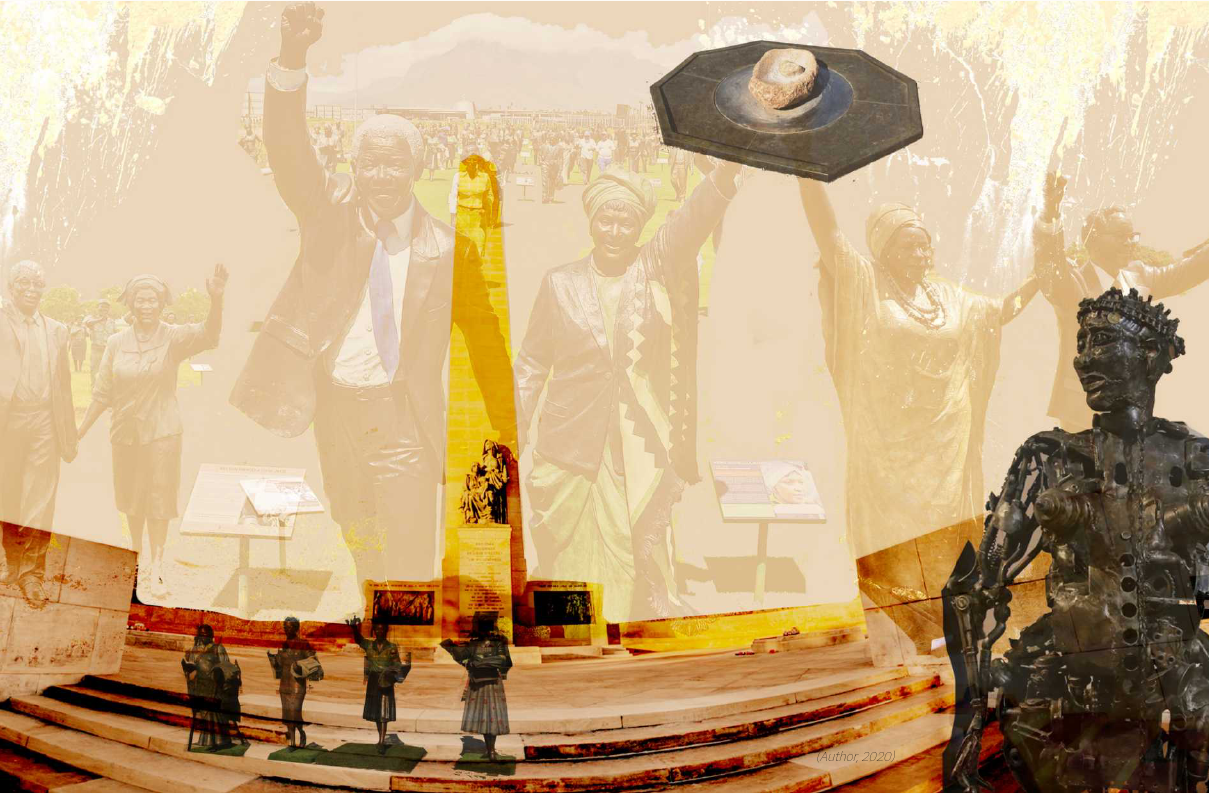
Representation| Empowerment
(Author, 2020)

Lit. Review |
Perception of Women|
In an attempt to try to understand why GBV takes place I started looking at how women have been represented in public spaces. The collage on the preceding page,
has some of the more recognised monuments/statues of women in South Africa. Some of these monuments, such as the statues of female freedom fighters at Union
Buildings, are inaccessible and so the visual of powerful women is not accessible to the public. The “Long Walk to Freedom” Exhibition in Century City shows women
such as Winnie Mandela, Albertina Sisulu with their husbands (Ishmail, 2019). These women played a monumental role in the fight for freedom as well as the fight for
equal rights for women and this representation (the women holding their husbands’ hands) downplays these women’s role in the struggle and shows them in a more
supportive role rather than their individual strength (Fourie, 2020). The National Women’s Monument in Bloemfontein has a large obelisk (which could be seen as a
phallic symbol), with the statue of a woman and child at a much smaller scale, being dwarfed by the obelisk (Fourie, 2020).
There are not enough images of empowering women in the South African context (for females to look up to and enough for men to view women as powerful beings)
(Davis, 2015). There is still a huge gap in the way that women and men are represented in the public realm (Groot, 2020). The memoralisation of people is also
outdated and has largely been controlled by men (Groot, 2020).
The ideas around representation and memoralisation of women ties into ideas, previously mentioned, around female empowerment as something that takes place
in the public realm. This exploration helped identify gaps in the public spaces
20
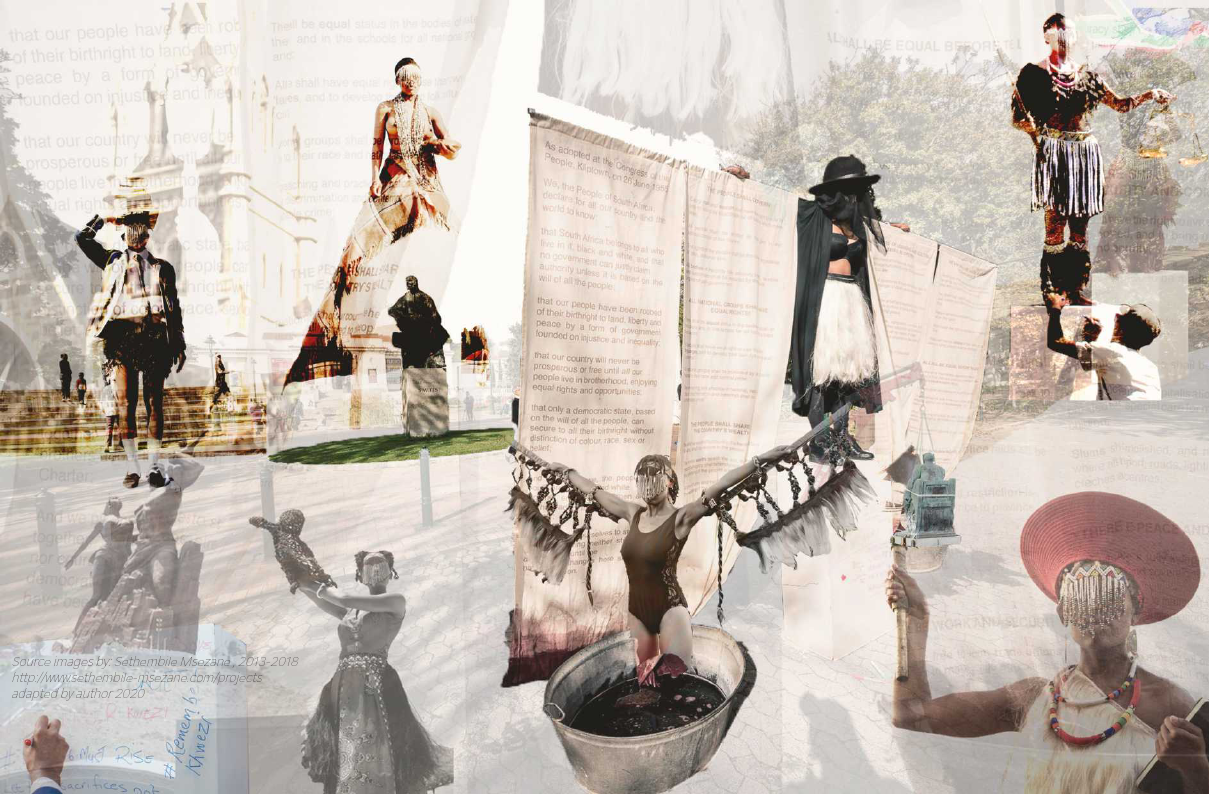
Representation| Empowerment
Source images by: Sethembile Msezane , 2013-2018
http://www.sethembile-msezane.com/projects
adapted by author 2020

Lit. Review |
Female Empowerment|
The South African artist Sethembile Msezane has, over the past few years, experimented with new ways of memoralisation (TEDTalks, 2017), and shifted the idea that
statues need to be permanent to be remembered through living sculpture and live performance. These living statues show women in a more realistic and relatable
form and have the ability to make one feel seen, recognized, understood and empowered (TEDTalks, 2017). The natural form, soft medium of the skin and fabric and
human scale of these living statutes make it easier for people to connect to what is being represented. The old ideals of how statues should be made and look (large,
dominant figures made with hard metals) creates a disconnect between the viewer and the subject matter.
Living in the age of social media, the digital realm has also played a large role in the preservation of the living sculptures which exist in the physical realm only
momentarily but live on within the digital space. Statues are often vandalised and their initial meaning is lost over time. In the digital realm, these living sculptures
and the initial thoughts behind them continue to exist together and so the meaning and significance of the work is not lost (Groot, 2020).
These ideals should be brought into public space to form more meaningful connections within the context they are intended. This can bring new energy into places
and be used as a tool to change the societal views of womxn and make womxn feel seen and empowered. These ideas can also initiate a much needed dialogue within
society about issues of gender inequality, GBV and trauma (both in womxn and men) making room for healing to take place.
22
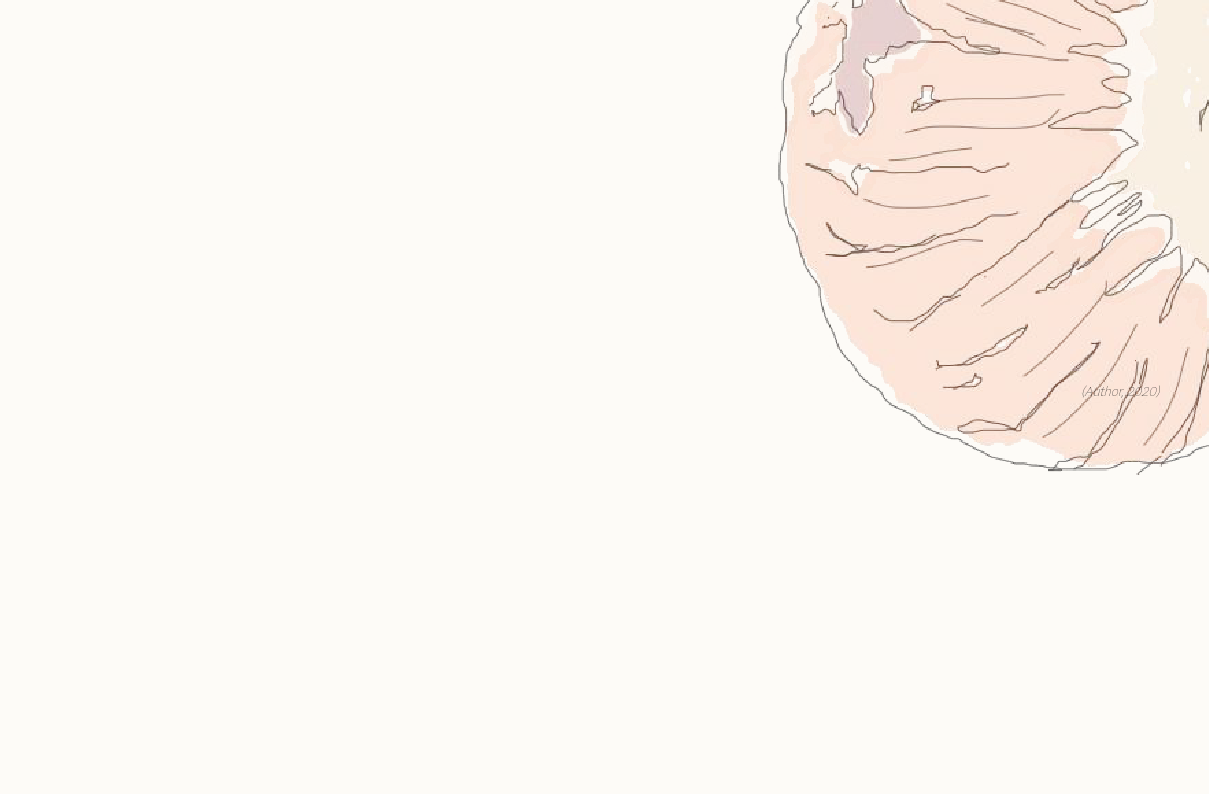
,, l)
'
METHODOLOGY|
(Author, 2020)

Observations & Mapping|
This project aims to create safe spaces for womxn for healing to take place. South Africa has one of the highest rates of Gender-based Violence
(GBV) and crime in the world. Many women do not feel safe being in public spaces.
Areas of crime/conflict/unsafe areas around Nyanga (as it is one the biggest contributors to crime and GBV in South Africa) have been identified
and mapped. Once these spaces had been identified on a larger scale, they were then interrogated at a much finer scale to understand the
quality of some of the spaces, the activities taking place around some of the crime hotspots and the public spaces that women in Nyanga occupy.
Once these areas had been interrogated, a primary “place of conflict” was identified and investigated, unpacking some of the site characteristics
that are contributing to crime, and in turn, some of the key issues that would have to be resolved in order to make this a safe space, understanding
the needs of the women occupying the space and how the space works and doesn’t work for them.
24
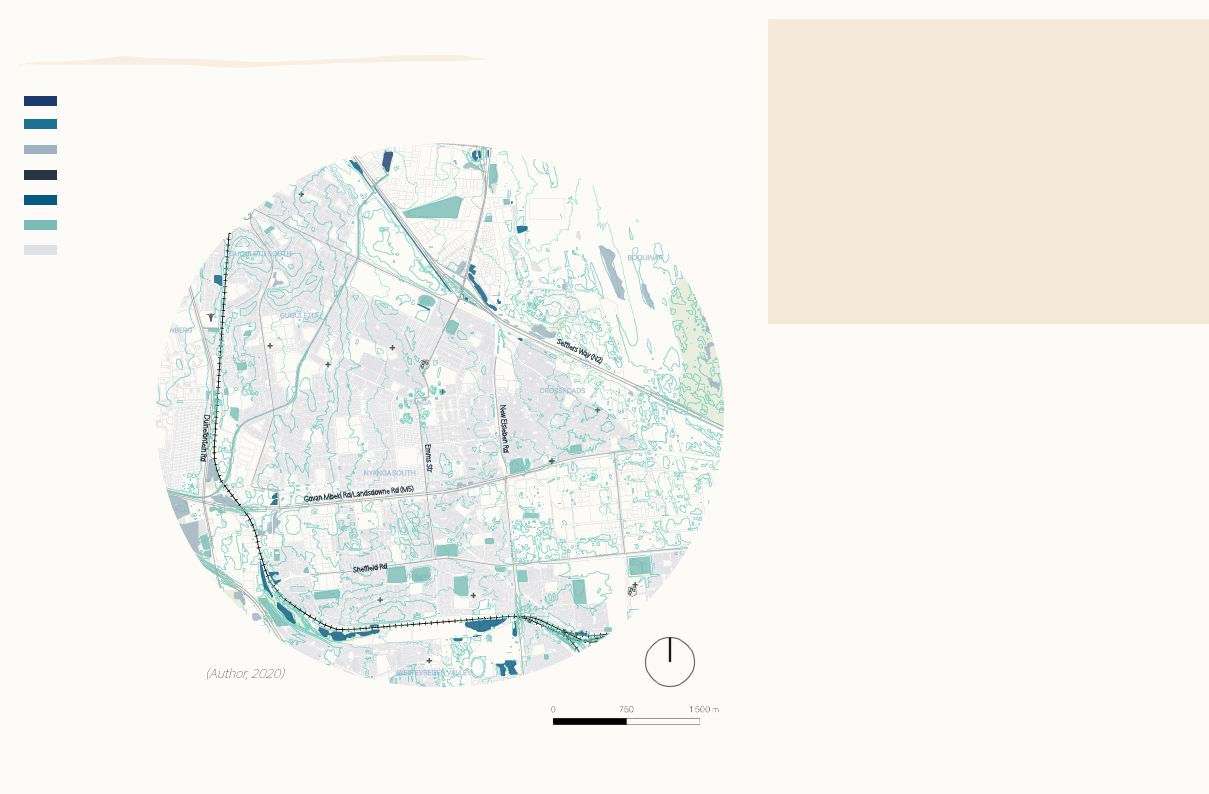
Mapping| natural
------
Effluent Pond
Irrigation pond
Natural and Semi-natural
Quarry
Stormwater depression
Stormwater pond
Transformed
NB
r/
/
.'~
.·-
.
'
.
(,
'I
.o
, <)
ii ( i .. s.. ·
\\l-. ~ .
~-✓1/
'
.
~
~,:;
GUGll.L
!
•
+)~,o>.D + ,
0
I\\\\ l
y }((
.
~ ·;;,
--~ (
1o
'(
• - · sour
NYANGA
Govan Mbeki Rd/Landsdowne Rd (M5)
Settlers Way (N2)
(Author, 2020)
·i
~.Q ,
Sheffield Rd
<""S"J
. ··"': . +
-.,-~~--; .,fow..~-fil.,-~,,-,R+rn,\\,!.b.,;..s.7;._.4'.,1~,1L. '
.
This map looks at the natural elements which exist in the area.
Understanding water around the area and the movement of water in
and around the area and the remnant vegetation.
It is argued that the sensory qualities of wild nature increase humans’
mental and physical health. Within landscape design; James Corner
argues that many designs focus more the visual representation of
nature rather than the entropic qualities of nature. He says that the
processes that take place in nature (the sensory experience or the
“sensation of nature”) are the elements that bring people closer to
nature. Rather than trying to design nature, landscape architects
should rather focus on the processes of nature. This will bring people
closer to nature, increasing their well-being as well as increasing the
health of the ecosystems (Ebbensgaard, 2017).
These natural elements and the processes could be used in the design
to create a sensory experience (using a medium that is familiar to the
people in the area) to draw women to the healing spaces and start the
healing process as well as improve the natural ecosystems.
The main flow of water is through the canal which starts up north and
drains south in the Zeekoevlei Dam. The landscape is quite flat and so the
boundaries of the river are artificially defined. The drainage patterns in the
Cape Flats area is was largely undefined, with seasonal wetlands scattered
across the area (which can be seen on the map) which dry up in the summer
months. Some of the wetlands have been altered to assist in some of the
urban interventions which have been introduced into the area. The wetland
in the south had the last patches of indigenous vegetation in Gugulethu. The
original Lotus river was extended and canalised to deal with run-off. The river
is not well kept. There is a lot of congestion due to rubbish dumping.
Aquifer:
The Cape Flats is considered to be a major aquifer. The water sits about
3-5m below ground level with ground water recharge potential between
100-200mm. The water is noticeably salty with 150-370mS/m (Electrical
conductivity) (Western Cape Department of Agriculture, 2019)
Soils:
The area consists of range of aoelian sand. The soils in the area as a whole are
greyish, sandy excessively drained soiled. These soils have limited pedological
development.(Western Cape Department of Agriculture, 2019)
Vegetation:
Cape Flats Dune Strandveld which is an endangered vegetation type. It
stabilises sand dunes. There is very little remnant vegetation. Indigenous
vegetation on the site would be preserved. (Western Cape Department of
Agriculture, 2019)
25
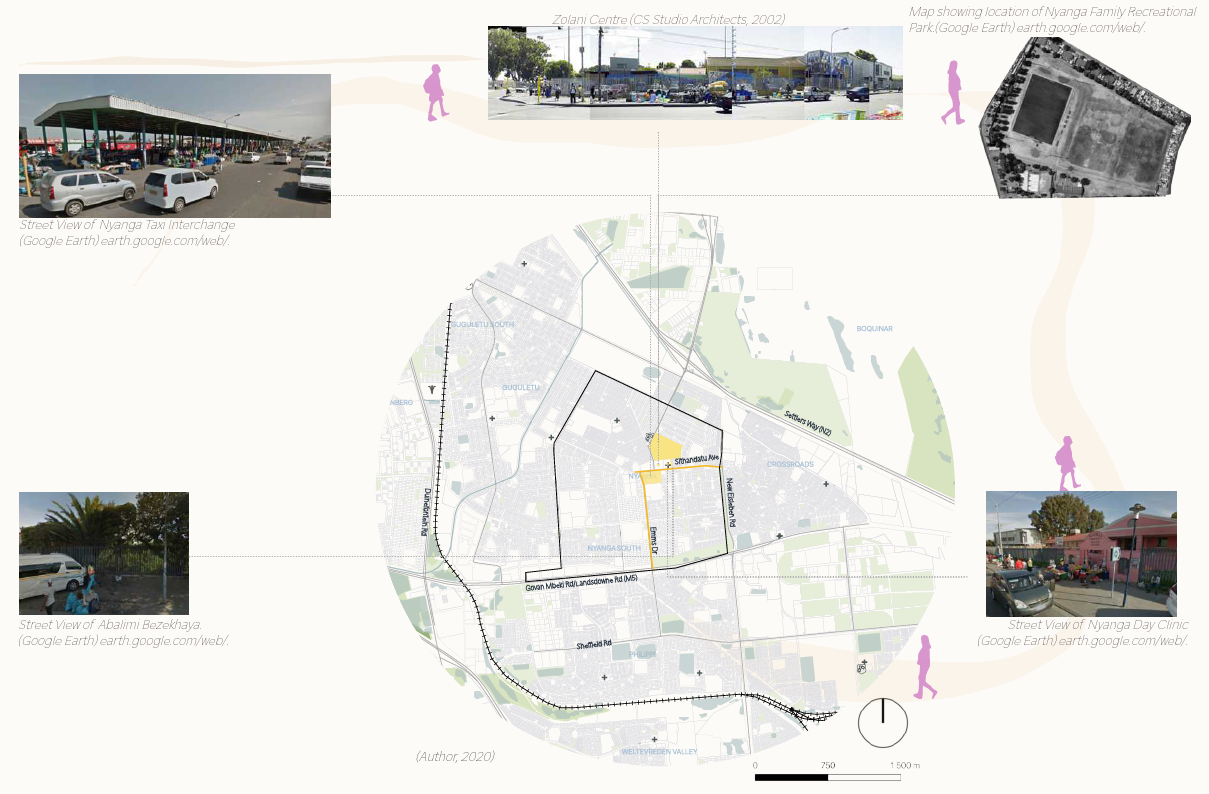
Mapping| The Node
Zolani Centre (CS Studio Architects, 2002)
Map showing location of Nyanga Family Recreational
Park.(Google Earth) earth.google.com/web/.
Street View of Nyanga Taxi Interchange
(Google Earth) earth.google.com/web/.
The Nyanga Taxi Interchange is the main transport node
in the area. During peak hours, commuters, buses and
taxis fill this space. Throughout the day informal traders
(mostly female) occupy this space, using the area covered
by the canopy as an informal market space. The area is
also filled with shipping containers used for trade activity.
Emms Drive is one of the main roads in Nyanga and is used
to get to the main node (around the taxi interchange) and
one of the main vehicular routes out and into the city. This
road is also considered to be the most dangerous road for
pedestrians with lots of violence taking place.
The Zolani Centre is the main community centre in Nyanga and is located
across the Taxi rank with a high amount of informal trade activity taking place
along its fence. This is a multi-purpose space used for sporting activities,
cultural activities as well as administrative work where residents are able to
claim and receive pensions and grants.
+
The Nyanga Family Recreational Park is the
main recreational space in the area. It has a
spray park and play space for children as well
as sports facilities. There is also a large amount
of under-utilised /undefined land which can
make this space dangerous to in .
Sithandatu Ave
Settlers Way (N2)
CAPE TOWN
INTERNATIONAL
AIRPORT
Sithandatu Ave is the main activity
CAPE TOWN spine in Nyanga with high amounts of
INTERNATIONAL
AIRPORT informal trade activity taking place along
the road. This is an area that women in
Nyanga occupy the most, where almost
all of the traders identified along this
spine being female.
';ROSSROADS
Street View of Abalimi Bezekhaya.
(Google Earth) earth.google.com/web/.
This is one of the sites of Abalimi Bezekhaya. This is a non-profit
organisation that intervenes in impoverished communities
by creating micro-farms and teaching them how to grow and
harvest plants to source food.
(Author, 2020)
I
(
NVANGASOUTH
..................l.. ........
.....il··.
Govan Mbeki Rd/Landsdowne Rd (M5)
- ·............................................................................................................
Sheffield Rd
+
+
I
+
WEIT REltN VALLEY
0
750
1500m
Street View of Nyanga Day Clinic
(Google Earth) earth.google.com/web/.
The Nyanga Community Health Centre
is a day clinic and the only medical facility
located in Nyanga. This is another space
that women occupy in Nyanga. The
services available at this clinic are TB, HIV
and STI care, childcare and family planning
(CoCT).
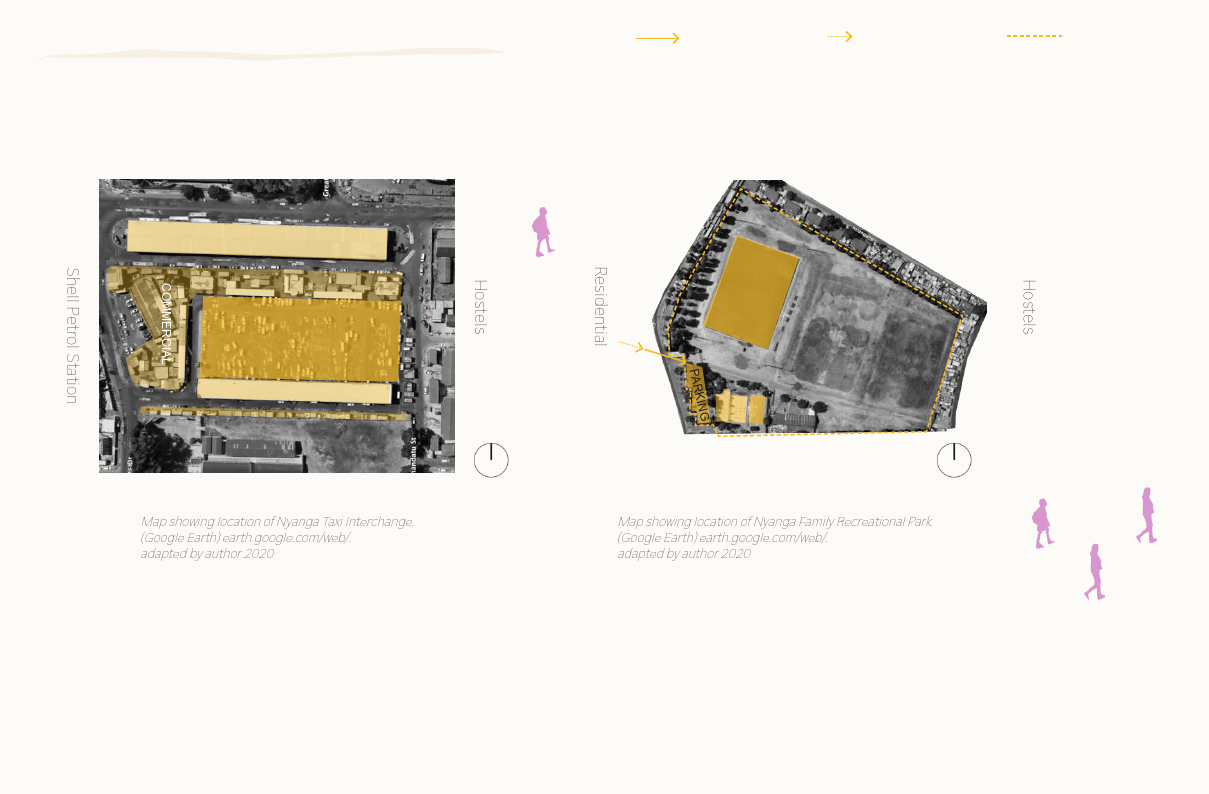
Mapping| The Node
NYANGA TAXI
INTERCHANGE
John Pama Primary
School
Zolani
Centre
INFORMAL TRADE
CONTAINERS
PARKING
COVERED TAXI PARKING
Oscar Mpetha High School
Map showing location of Nyanga Taxi Interchange.
(Google Earth) earth.google.com/web/.
adapted by author 2020
The Nyanga Taxi Interchange functions both as a commercial and
transport hub. It therefore generates a lot of foot traffic and has many
vehicles (mainly public transport systems such as taxis and buses)
moving through the space. The area is mostly free flowing and open and
so, it is easy for people in the space to see what is happening around
the site. There are two canopy structures (informal trade and covered
taxi parking) in the space. This type of structure works well in the space
as it protects people from the elements while still allowing for visual
and physical permeability. The spaces between the commercial and
container zones can be unsafe as the structures created moments of
obstructed views.
vehicular
)
entry
pedestrian
entry
NYANGA FAMILY
RECREATIONAL PARK
Nyanga Police
Station
Hostels
fencing
SOCCER
FIELD
UNDER-
UTILISED/
UNDEFINED
LAND
PLAY
AREA
Zolani
Centre
Map showing location of Nyanga Family Recreational Park.
(Google Earth) earth.google.com/web/.
adapted by author 2020
The Nyanga Family Recreational Park is a large area with very few
defined spaces. The area is also fenced off with one main access point
into the site which limits access to the space. There is a soccer field with
floodlights and spectator seating as well as parking for visitors of the
space. There is play space and spray park (which was introduced as a
fun way of educating children about water) and netball court but these
spaces have been vandalised and some of the equipment is not usable.
There rest of the site consists of undefined space. This spaces have little
to no activity and with little activity bringing people to the space, there
is not a lot of surveillance throughout the day, making the area unsafe.
27
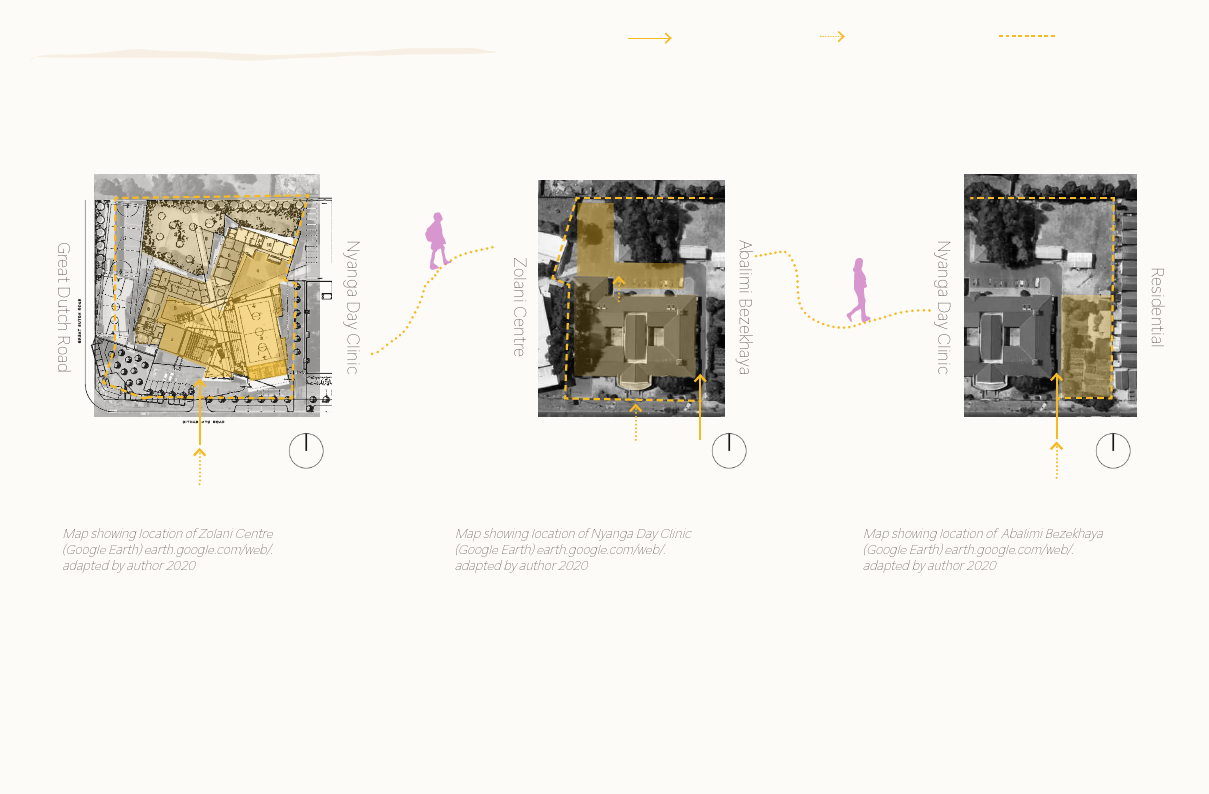
Mapping| The Node
ZOLANI CENTRE
Nyanga Family
Recreational Park
i . ............:....... ......
vehicular
)
entry
·······)
pedestrian
entry
fencing
NYANGA DAY CLINIC
Nyanga Family
Recreational Park
ABALIMI BEZEKHAYA
Nyanga Family
Recreational Park
· · ·.·. 1
l...·•......... ......·····
Sithandatu Ave
Map showing location of Zolani Centre
(Google Earth) earth.google.com/web/.
adapted by author 2020
Sithandatu Ave
Map showing location of Nyanga Day Clinic
(Google Earth) earth.google.com/web/.
adapted by author 2020
Sithandatu Ave
Map showing location of Abalimi Bezekhaya
(Google Earth) earth.google.com/web/.
adapted by author 2020
The Zolani Centre is a mix-use facility which has private office space
for administrative workers and public spaces which can be used by the
community. The indoor public facilities (which includes the basketball
court, theatre space and open meeting/gathering areas are located
closest to the main street edge (Sithandatu Ave). The public outdoor
facilities (such as the garden space and netball court etc) are located
closest to the Nyanga Family Park. This site is fenced off which limits
access to the community to the spaces which have been made for
them. This fence and the parking also takes up space which can be
used by the informal traders just outside the fence.
The Nyanga Day Clinic is the only medical facility in Nyanga and is an
area the women occupy. Female informal traders set up their stall along
either side of the entrance and almost act as guardians to this space,
watching who goes in and out of the clinic. This intense surveillance
makes this space safe for women to move through.
There is parking north of the clinic which is used by staff members. The
clinic also shares this property with the Abalimi Bezekhaya site. There
is a fence around the property to restrict access and keep the property
safe.
The Abalimi Bezekhaya site is located on the same property as the
day clinic and the two spaces share an access point. This site is fence
off to restrict access to the area and helps to keep the produce safe
(from looting). The main micro-farming garden space is clearly defined
and populated by plants but the rest of the site is not being used. This
farming activity could be extended to help grow and supply my food fo
the community.
28
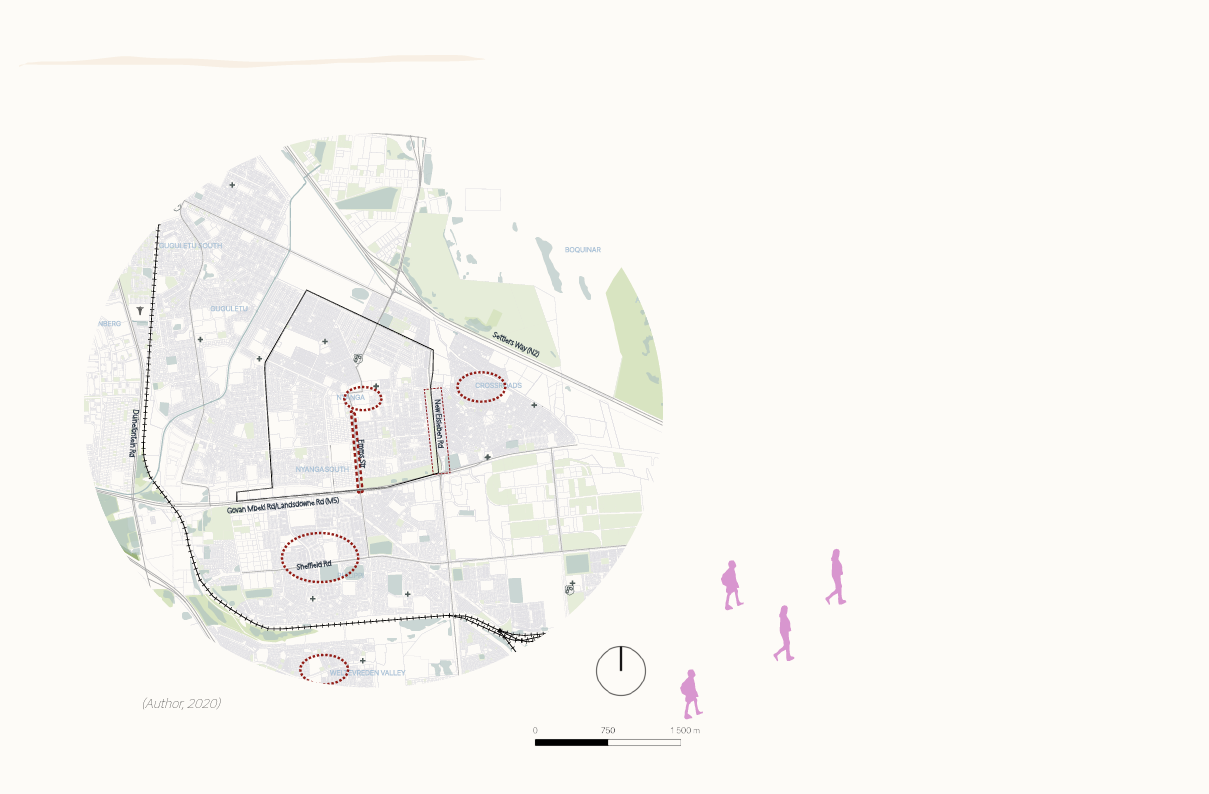
Mapping| Crime Hotspots
+
1
2
Govan Mbeki Rd/Landsdowne Rd (M5)
Sheffield Rd
'•
~ ...
'
••
BOQUINAR
\\
CAPE TOWN
INTERNATIONAL
AIRPORT
Settlers Way (N2)
. .·•········•• • CR( ,S~t)ADS
•♦•·······••
3
CAPE TOWN
INTERNATIONAL
AIRPORT
i
(Author, 2020)
... --···· ~·········••._:
+
VR
:N VALLEY
i
0
750
1500 m
In creating a safe space for women it was important to
note and map of the unsafe spaces in the area. These
spaces could make it difficult for women to occupy these
spaces or make access to nearby spaces harder.
When looking at issues around safety in the area as a
whole, there are three crime hotspots which have been
located in Nyanga. These are spaces where cases of
aggravated robbery and murder occur more frequently
(Edelstein, Arnott, and Faull, 2020).
Hotspot 1 is the area in and around the Nyanga taxi
interchange and is located very close to the police
station. Originally, the police station was assumed as an
element that would add a layer of safety to the site but in
mapping the crime hotspots, it was made clear that this
was not the case. Upon further investigation it was noted
that the police in Nyanga are afraid to patrol the area
even during the day because of the high levels of crime
(Safetylab, 2013).
Hotspot 2 is Emms Drive which has been identified by
residents as the most dangerous road for pedestrians
which high amounts of gang violence taking place along
this spine (Safetylab, 2013).
1
1
Hotspot 3 is along New Eisleben Rd. This area is a large
string of empty land nestled between a main road and
a residential road. The lack of activity along the empty
piece of land layered with the adjacent, vehicle dominant
, road are what make this strip unsafe for pedestrians.
There is no surveillance and so people walking through
this space alone or in a small group a left exposed to
aggregated theft and murder.
29
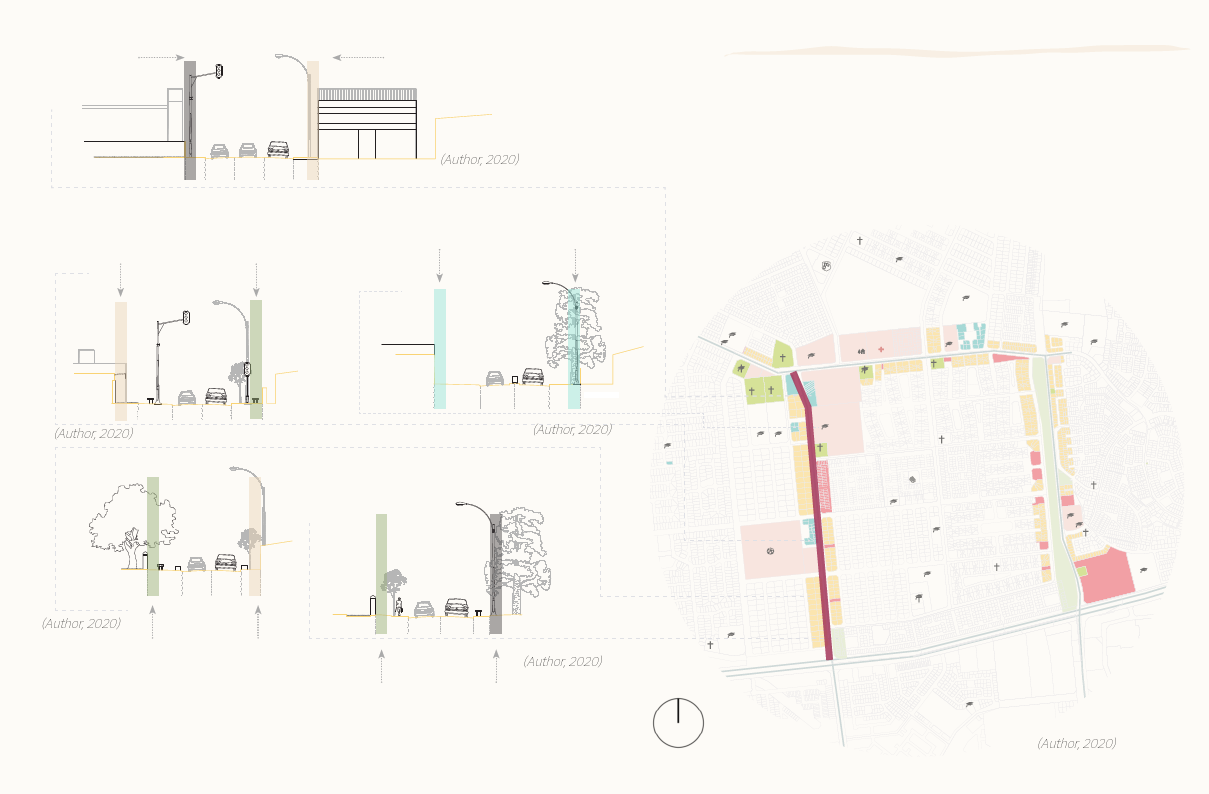
RESIDENTIAL
RESIDENTIAL
PAVEMENT
PAVEMENT
EMMS DRIVE
Dead edge:
Fencing and the empty
plot leads to lack of
...............►
activity/surveillance.
l
EMMS DRIVE
PAVEMENT
OPEN LANPDAVEMENT
OPEN LAND
RESIDENTIAL
RESIDENTIAL
PAVEMENT
-C:················· PRODUCED BY AN AUTODESK STUDENT VERSION
PAVEMENT
EMMS DRIVE
EMMS DRIVE
PAVEMENT
/DROP OFF
Active edge:
PAVEMENT
RESIDEN/DTRIAOLP OFF
Commercial activity
spills out onto the street
which adds surveillance.
RESIDENTIAL
II 1111 II 111
DUNLOP
PAVEMENT
RESIDENTIAL
YXSIZE
XYSIZE
XYSIZE
YXSIZE
OPEN LAND
PAVEMENT
EMMS DRIVE
BOYS 2 MEN BARBER SHOP
J_
PAVEMENT/
PARKING
COMMERCIAL
0
5
10
(Author, 2020)
SCALE BAR 1:100
OPEN LAND
SPAZA SHOP
BETWEEN
RESIDENTIAL
SPAZA SHOP
PAVEBMEETNWTEEN
/DRROEPSOIDFEFNTIAL
PAVEMENT
/EDMRMOSP DORFIFVE
EMMS DRIVE
PAVEMENT
PAVEMENT RESIDENTIAL
RESIDENTIAL
Active edge:
Spaza overhang gives RESIDENTIAL
PAVEMENT
the pavement a human
scale & level of comfort
Medium edge:
High wall of residence EMMSDRIVE
PAVEMENT
RESIDENTIAL
/DROP OFF
limits views but house
faces street.
YXSIZE
Dead edge: YXSIZE
Dead edge:
Tall building with dead High fencing and school COMMERCIAL
COMMERCIAL
PAVEMENT
PAVEMENT
EMMS DRIVE
EMMS DRIVE
PAVEMENT
PAVEMENT
RESIDENTIAL
RESIDENTIAL
facade leads to lack of looks inward (away from TRANSPORTINTERCHANGE
(USED AS INFORMAL
TRADING)
ROAD THROUGH TRANSPORT
INTERCHANGE
activity along the edge.
street).
CONTAINERS
WITH TRADING
TRANSPORT INTERCHANGE
(USED AS INFORMAL
TRADING)
TRANSPORT INTERCHANGE
(USED AS INFORMAL
TRADING)
Safety| edge conditions ROADTHROUGHTRANSPORT
ROAD THROUGH TRANSPORT
INTERCHANGE
CONTAINERS
INTERCHANGE
WITH TRADING
CONTAINERS
WITH TRADING
Emms Drive (highlighted in red below) is one of the main roads leading up to the area of
focus. It is considered to be the most dangerous roads, nicknamed “the red carpet” by the
locals because of the bloodshed from stabbings and shootings leading to severe injuries or
15 murde2r0s taking place there (Safetylab. 2013). The road has little surveillance with the houses
having high boundary walls and being stepped back far from the street. There are areas with
open/empty plots of land. The lack of surveillance along this road makes the area unsafe,
where people can easily commit crime and escape without anyone seeing. Few people can
be found along this road and women are usually accompanied when moving along this road.
Emms Drive gives clues as to what is not working in the area and is a good informant for the COMMUNITY
type of edge conditions and spaces that women do not feel safe and won’t occupy. CENTRE
COMMUNITY PAVEMENT
CENTRE(USED AS INFORMAL
TRADING)
PAVEMENT
(USED AS INFORMAL
TRADING)
SITHANDATU AVE
SITHANDATU AVE
PAVEMENT
TRANSPPOARVTEMINETNETRCHANGE
(USED AS INFORMAL
TRADING)
TRANSPORT INTERCHANGE
(USED AS INFORMAL
TRADING)
t
~
RESIDENTIAL
RESIDENTIAL
ESIDENTIAL
,.
YXSIZE
YXSIZE
-
L~J_ -· ]
RESIDENTIAL
11
RESIDENTIAL
PAVEMENT
YXSIZE
COMMERCIAL
PAVEMENT
(Author, 2020)
YXSIZE
RESIDENTIAL
XYSIZE
RESIDENTIAL
PAVEMENT
COMMERCIAL
(Author, 2020)
PAVEMENT
(USED AS EXTENSION
OF STORE)
t
Medium edge:
High wall of residence
limits views but house
faces street.
',,''i1 ,r
,. ~
t ,.
,t,
4ft +
,t, I
,. ..i
~
,.
t
~
PAVEMENT
EMMS DRIVE
EMMS DRIVE
PAVEMENT
PAVEMENT
RESIDENTIAL
RESIDENTIAL
COMMERCIAL
COMMERCIAL
PAVEMENT
(USED AS EXTENSION
OF STORE)
PAVEMENT
EMMS DRIVE
(USED AS EXTENSION
OF STORE)
EMMS DRIVE
PAVEMENT
PAVEMENT
RESIDENTIAL
RESIDESNCTHIAOLOL
RESIDENTIAL
t t PAVEMENT
RESIDENT(UIASLED AS
PARKING)
PAVEMENT
(USED AS
PARKING) SITHANDATU AVE
SITHANDATU AVPEAVEMENT
(USED AS INFORMAL
TRADING)
PAVEMENT
(USED AS INFORMAL
TRRAEDSIINDGE)NTIAL
RESIDENTIAL
EMMS DRIVE
PAVEMENT
RESIDENTIAL
I
L
COMMUNITY
CENTRE
PAVEMENT
(USED AS INFORMAL
TRADING)
SITHANDATU AVE
(Author, 2020)
PAVEMENT
TRANSPORT INTERCHANGE
(USED AS INFORMAL
TRADING)
,.
-
DUNLOP
DUNLOP
BOYS 2 MEN BARBER SHOP
BOYS 2 MEN BARBER SHOP
PEAMVMESMEDNRTIVE
EMMS DRIVE
EMMS DRIVE
PAVEMENT
PAVEMENT
RESIDENTIAL
RESIDENTIAL
PAVEMENT
t
RESIDENTIAL
YXSIZE
YXSIZE
YXSIZE
YXSIZE
YXSIZE
YXSIZE
YXSIZE
YXSIZE
OPEN LAND
OPEN LAND
PAVEMENT
RESIDENTIAL
RESIDENTIAL
PAVEMENT
EMMS DRIVE
PAVEMENT
EMMS DRIVE
PAVEMENT
(USED AS
PARKING)
EMMS DRIVE
PAVEMENT/
PARKING
PAVEMENT/
PARKINGCOMMERCIAL
COMMERCIAL
PAVEMENT
SITHANDATU AVE
(USED AS INFORMAL
TRADING)
RESIDENTIAL
PAVEMENT
OPEN LAND
RESIDENTIAL
PAVEMENT
Good edge:
No fencing on house +
house facing street adds
t
t (Author, 2020)
surveillance
Medium edge:
Dead edge:
High wall of residence Empty plot leads to lack
limiDtUsNvL OieP ws but house of activity/surveillance
faces street.
BOYS 2 MEN BARBER SHOP
0
5
10
15
,. EMMS DRIVE
t
--
20
,. ~
,.
PRODUCED BY AN AUTODESK STUDENT VERSION
t
t
0
05
•
~
5 10
1015
1520
I•... t
. ,.,.
t
20
SCALE BARSC1A:1L0E0 BAR 1:100
~
- t
-
,,..
PAVEMENT
/DROP OFF
RESIDENTIAL
-- --
-~~ I TRANSPORT INTERCHANGE
(USED AS INFORMAL
TRADING)
(Author, 2020)
YXSIZE
XYSIZE
XYSIZE
YXSIZE
OPEN LAND
PAVEMENT
EMMS DRIVE
PAVEMENT/
PARKING
COMMERCIAL
SCALE BAR 1:100
,.
ROAD THROUGH TRANSPORT
INTERCHANGE
30
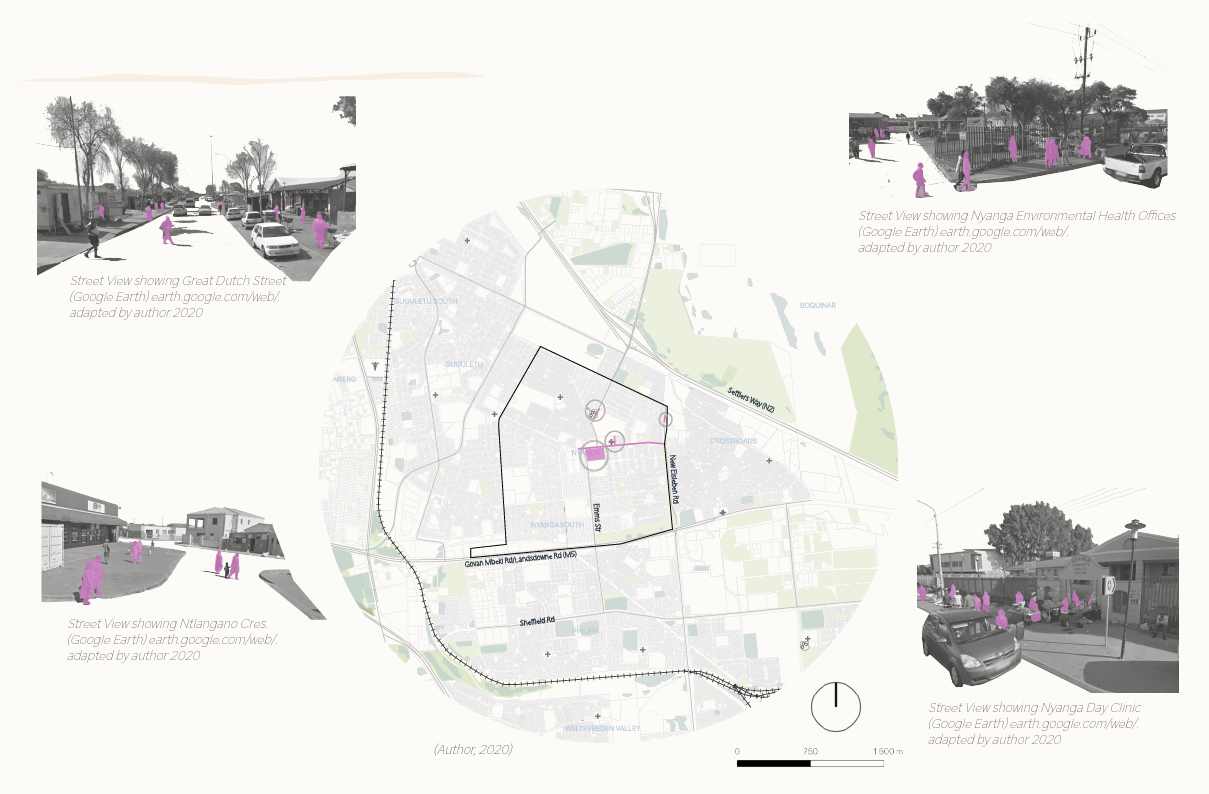
Spaces for Women| activity
Street View showing Great Dutch Street
(Google Earth) earth.google.com/web/.
adapted by author 2020
There are trade facilitites which have been added
along Great Dutch Street (which is the road between
the Nyanga Family park and the police station). N9 R(
Surveillance is added through the activity from the
police station as well as the foot traffic moving north
towards hostels/residential zone. There are female
trading stalls which have developed here due to this
activity.
The Department of Home Affairs and the
Nyanga Environmental Health Offices are
both located in the area pictured on the right.
The activity generated by these facilities add
surveillance to the space and so more women
can be found here There are a few female
traders, as well as female trash collectors who
move along this street.
Street View showing Nyanga Environmental Health Offices
(Google Earth) earth.google.com/web/.
adapted by author 2020
Settlers Way (N2)
CAPE TOWN
INTERNATIONAL
AIRPORT
The image below shows Nyanga Day Clinic
(situated along Sithandatu Ave which is a road
that is mostly occupied by women) and the
CAPE TOWN way women occupy this space. The female
INTERNATIONAL traders act as an extension to the entrance of
AIRPORT
this space. Unlike the other examples of spaces
occupied by women explored on this page, the
women along this street and especially along
the clinic’s entrance actually hold and guard
the space. This is more than just a space that
they are able to occupy/exist..
Street View showing Ntlangano Cres.
(Google Earth) earth.google.com/web/.
adapted by author 2020
The activity taking place along Great Dutch Street
creates moments of safety around this zone. The image
above show one of those zones. There is a spaza shop
and a liquor store which pull from the energy taking
place on Great Dutch Street at certain times of the day
and make this zone safe to pass through.
Govan Mbeki Rd/Landsdowne Rd (M5)
Sheffield Rd
+
+
(Author, 2020)
+
ALLEY
Street View showing Nyanga Day Clinic
(Google Earth) earth.google.com/web/.
0•-----75c0======1:J500m adapted by author 2020
31
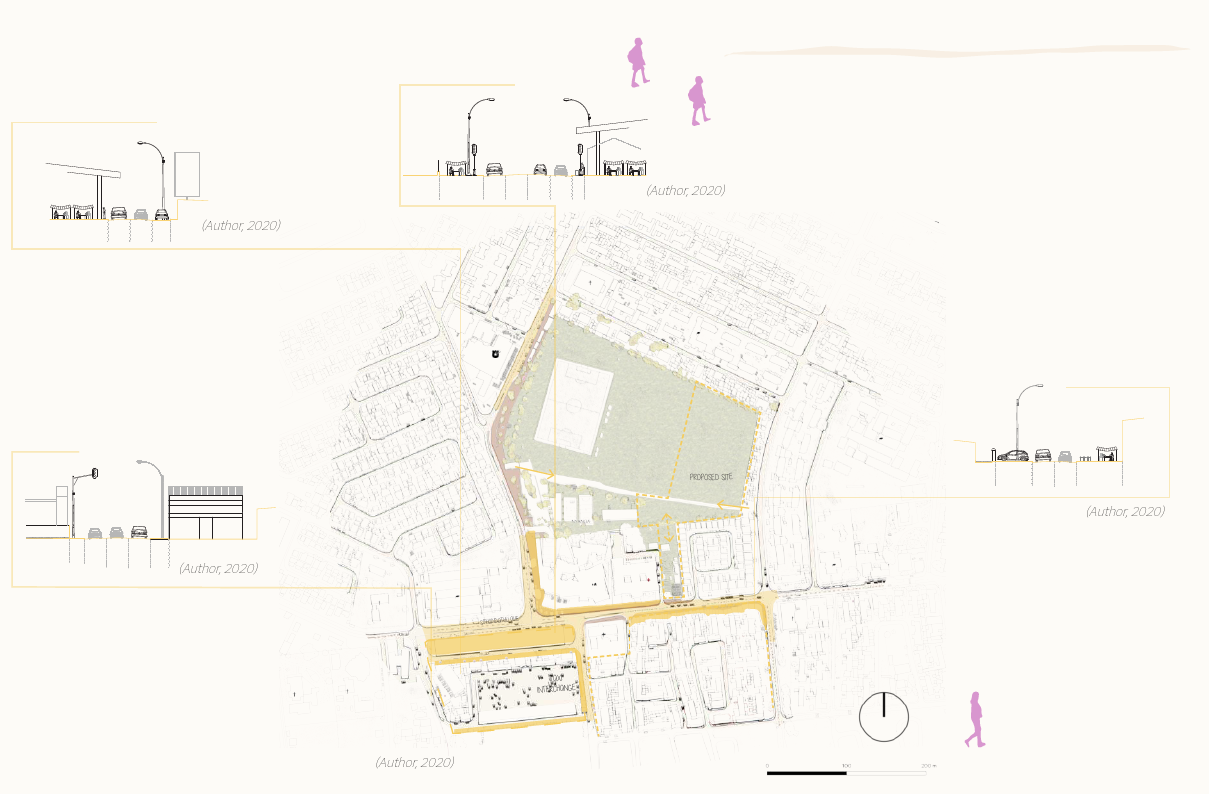
PAVEMENT
EMMS DRIVE
PAVEMENT
OPEN LAND
RESIDENTIAL
PAVEMENT
EMMS DRIVE
PAVEMENT
/DROP OFF
EMMS DRIVE
PAVEMENT RESIDENTIAL
---------------- .
RESIDENTIAL
PAVEMENT
/DROP OFF
RESIDENTIAL
The area with the interchange
and community centre has trade PAVEMENT
EMMS DRIVE
PAVEMENT
/DROP OFF
RESIDENTIAL
taking place on both sides of the
road. The interchange sheltering
structure is occupied only by
traders (mostly women). There
is a lot of activity around this area TRANSPORTINTERCHANGE
(USED AS INFORMAL
ROAD THROUGH TRANSPORT
INTERCHANGE
TRADING)
with people constantly moving
through the space.
YXSIZE
COMMERCIAL
PAVEMENT
EMMS DRIVE
PAVEMENT
RESIDENTIAL
COMMUNITY
CENTRE
TRANSPORT INTERCHANGE
(USED AS INFORMAL
TRADING)
CONTAINERS
WITH TRADING
PAVEMENT
(USED AS INFORMAL
TRADING)
ROAD THROUGH TRANSPORT
INTERCHANGE
CONTAINERS
WITH TRADING
Spaces for Women| activity
SITHANDATU AVE
RESIDENTIAL
PAVEMENT
PAVEMENT
TRANSPORT INTERCHANGE
(USED AS INFORMAL
TRADING)
EMMS DRIVE
PAVEMENT
(Author, 2020) OPENLAND
RESIDENTIAL
PRODUCED BY AN AUTODESK STUDENT VERSION
This study was shows the spaces that women occupy in Nyanga and how they move through
this space. The trade activity taking place along Sithandatu Avenue (highlighted below) is
female dominated. They have informal trading stalls along the pavement and in the taxi
interchange. There are containers with salons and food stalls that are owned and operated by
women around the taxi interchange. Trade takes place on both sides of the road but the areas
where the residential buildings are, trade takes place only along the one side of the street, but
still densely packed, and the other side is used mostly as parking.
PAVEMENT
EMMS DRIVE
PAVEMENT
/DROP OFF
RESIDENTIAL
TRANSPORT INTERCHANGE
(USED AS INFORMAL
TRADING)
ROAD THROUGH TRANSPORT
INTERCHANGE
CONTAINERS
WITH TRADING
TRANSPORT INTERCHANGE
(USED AS INFORMAL
TRADING)
ROAD THROUGH TRANSPORT
INTERCHANGE
(Author, 2020) CONTAINERS
WITH TRADING
The
XYSIZE
small slip street COMMERCIAL
PAVEMENT
EMMS DRIVE
PAVEMENT
with RESIDENTIAL
the
taxi
interchange has informal trade happening
under the shading structure and trade PAVEMENT
EMMS DRIVE
PAVEMENT
RESIDENTIAL
taking place in metal containers. These COMMERCIAL
PAVEMENT
(USED AS EXTENSION
OF STORE)
EMMS DRIVE
containers hold a lot of the salons in
the area as well as a few food vendors.
Although this area is meant to serve as a PAVEMENT
TRANSPORT INTERCHANGE
COMMUNITY
CENTRE
(USED AS INFORMAL
TRADING)
SITHANDATU AVE
PAVEMENT
(USED AS INFORMAL
TRADING)
taxi interchange, it seems that many of
the taxis and buses stop along Sithandatu
COMMERCIAL
PAVEMENT
EMMS DRIVE
PAVEMENT
RESIDENTIAL
(USED AS EXTENSION
Avenue rather OFSTORE) than the slip street within
the interchange.
AVEMENT
EMMS DRIVE
PAVEMENT
RESIDENTIAL
7.......(:)
_L ! RESIDENTIAL
PAVEMENT
(USED AS
PARKING)
SITHANDATU AVE
XYSIZE
XYSIZE
YXSIZE
YXSIZE
OPEN LAND
PAVEMENT
EMMS DRIVE
PAVEMENT
(USED AS INFORMAL
TRADING)
RESIDENTIAL
DUNLOP
BOYS 2 MEN BARBER SHOP
YXSIZE
XYSIZE
XYSIZE
XYSIZE
OPEN LAND
PAVEMENT
EMMS DRIVE
PAVEMENT/
PARKING
COMMERCIAL
(Author, 2020)
COMMUNITY
CENTRE
PAVEMENT
(USED AS INFORMAL
TRADING)
SITHANDATU AVE
PAVEMENT
TRANSPORT INTERCHANGE
(USED AS INFORMAL
TRADING)
PAVEMENT
RESIDENTIAL
~
RESIDENTIAL
.-Y, \\'
PAVEMENT
(USED AS
PARKING)
)\\
RESIDENTIAL
.\\ ,\\
~
\\\\
\\\\
PAVEMENT
(USED AS
PARKING)
,I
DUNLOP
SITHANDATU AVE
PAVEMENT
(USED AS INFORMAL
TRADING)
RESIDENTIAL
BOYS 2 MEN BARBER SHOP
0
SITHANDATU AVE
PAVEMENT
(USED AS INFORMAL
SPAZA SHOP TRADING) PAVEMENT
BETWEEN
/DROP OFF
RESIDENTIAL
RESIDENTIAL
EMMS DRIVE
5
10
15
PAVEMENT/
PARKING
COMMERCIAL
SCALE BAR 1:100
YXSIZE
RESIDENTIAL
PAVEMENT
EMMS DRIVE
PAVEMENT RESIDENTIAL
20
PAVEMENT
RESIDENTIAL
0
5
10
15
20
SCALE BAR 1:100
There is a0 more5 forma1l0ised t1r5ade a2c0tivity
taking plaScCeALE BinAR 1:t1h00is area with a mix of
shipping containers and built form for some
of the other spaces. This contains a few of
the salons and a few other stalls. There
aren’t any informal trading stalls along this
area and this activity mostly happens along
the main road.
XYSIZE
RESIDENTIAL
SITHANDATHU AVE
PAVEMENT
EMMS DRIVE
PAVEMENT
RESIDENTIAL
TAXI
INTERCHANGE
YXSIZE
COMMERCIAL
PAVEMENT
EMMS DRIVE
PAVEMENT
RESIDENTIAL
COMMERCIAL
PROPOSED SITE
PAVEMENT
(USED AS EXTENSION
OF STORE)
EMMS DRIVE
PAVEMENT
RESIDENTIAL
YXSIZE
YXSIZE
YXSIZE
YXSIZE
OPEN LAND
PAVEMENT
EMMS DRIVE
DUNLOP
BOYS 2 MEN BARBER SHOP
PAVEMENT/
PARKING
COMMERCIAL
Women occupy this space due to the high activity
taking place and the constant surveillance in the
area. The taxi interchange (labelled below) contains
a high number of female traders even though it has
been highlighted as a crime hotspot however, most
of this crime takes place due to the extremely high
movement of people in the early morning and is
COMMUNITY
CENTRE
PAVEMENT
(USED AS INFORMAL
TRADING)
reduced after peak hour.
SITHANDATU AVE
PAVEMENT
TRANSPORT INTERCHANGE
(USED AS INFORMAL
TRADING)
RESIDENTIAL
PAVEMENT
(USED AS
PARKING)
SITHANDATU AVE
PAVEMENT
(USED AS INFORMAL
TRADING)
RESIDENTIAL
(Author, 2020)
The area along Sithandatu Avenue
where the houses and hostels are on
either side of the road only has trade
on one sid0e of the5 road (1t0he side15 where20
the hostelSsCAaLEreBA)R. 1M:100any of the houses
have fencing/a clear boundary and the
hostels on the south side have been
defined by the trade taking place along
the pavement. These stall structures
seem more permanent than the stalls
closer to the interchange.
(Author, 2020)
100
32
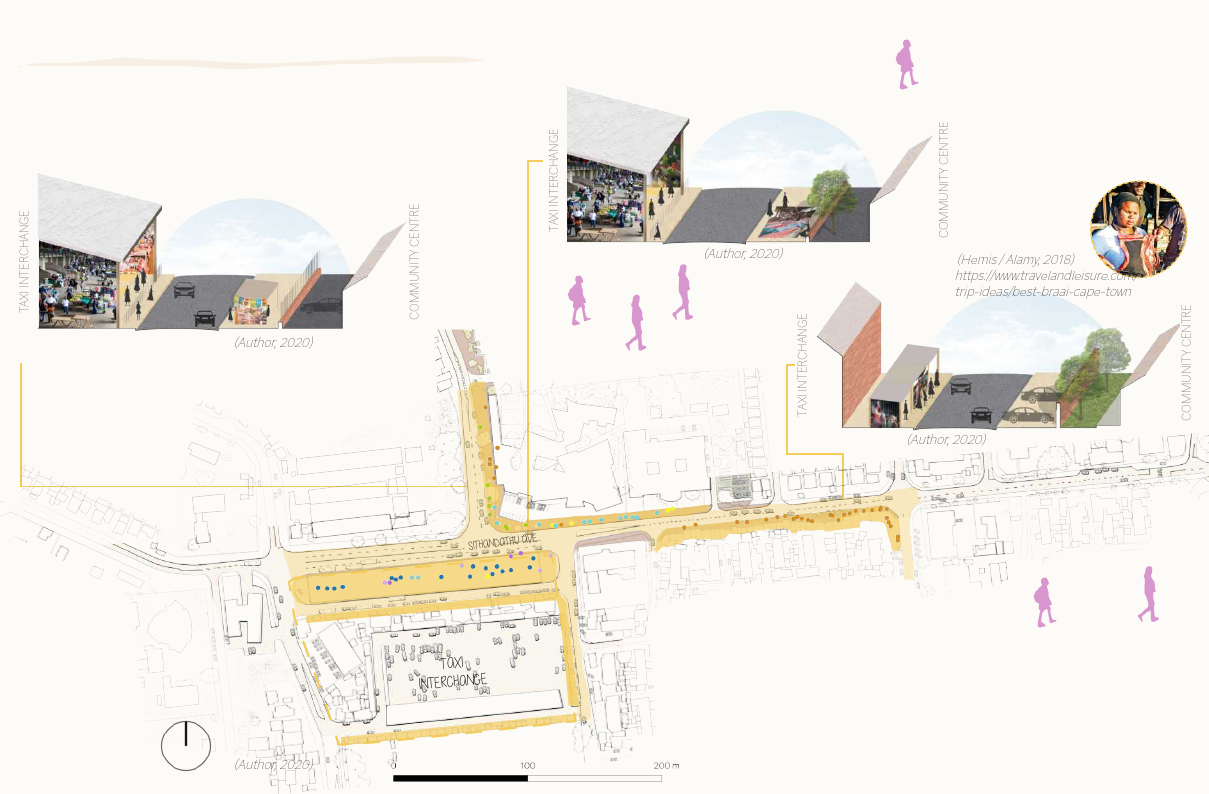
The Stalls| typology
The types of stalls in and around Sithandatu Avenue have organically developed
according to the type of activity taking place close by; and form clusters of trade activity
(which can be observed on the street plan below).
(Author, 2020)
The vendors around the interchange mostly cater to travellers and women and
this can be seen by types of goods and services offered here. There is a lot of
female clothing sold within the interchange (mostly domestic worker uniforms or
clothes worn when doing chores within the home), as well as cleaning supplies.
On the other side of the road, are fruits, snacks, deodorant, gadgets, etc which
would typically be bought by people on the move.
SITHANDATHU AVE
0
', [
~; ~I/ . ~ (Author, 2020)
TAXI
INTERCHANGE
(Author, 2020)
The trade still takes place on both sides of the
road but there is a slight shift in trade taking
place moving east towards the residential
area. The vendors are still mostly catering
to travellers but this begins to merge with
the needs of the local residents. The goods
sold are mostly the same with the clothing
sold (mostly on the side of the road with the
community centre) now including casual
clothing for children, men and women.
(Hemis / Alamy, 2018)
https://www.travelandleisure.com/
trip-ideas/best-braai-cape-town
(Author, 2020)
The trade taking place along is situated within a residential zone. Although there
is still dense trade activity taking place, it only happens along one side of the road
(the side of the road that the hostels are located). The trade taking place along here
is mostly cooked/braai’d food (indicated with orange dots in the above plan). These
traders almost act as “take-away” spots (food which is typically bought when no one
is able to cook as they are busy, working late, too tired or would like a treat). The
smells from this area would draw in people around the neighbourhood.
33
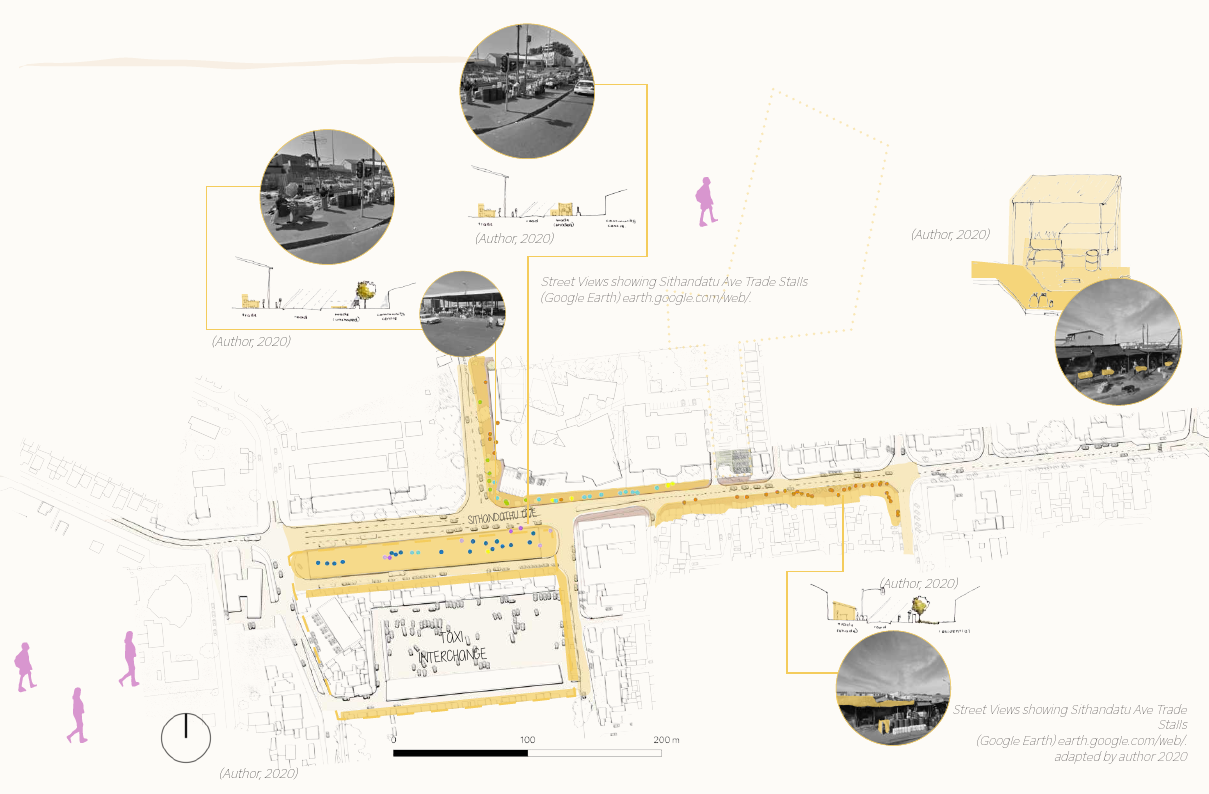
The Stalls| conditions
The stalls are mostly made of materials found around the site or are located
within existing sheltered areas.
The taxi interchange has a
shaded structure, underneath
there are tables arranged
around the surface for traders
to set up stalls each day.
On the other side of the
road are fenced facilities
and the trade takes place
along that edge, with some
vendors assembling and
disassembling shelters each
day or setting up a blanket
and displaying goods on here
(sitting on the floor or the wall
and using the nearby trees for
shading).
(Author, 2020)
The stalls closer to the hostels look like they have been made
by the stall-owners with materials found around the area. These
include cardboard, steel, fabric, plastic and timber. Some of these
materials were explored in order to understand how they could
be used, and sourced and also to understand the conditions that
the women work under. The stalls along these edge seem more
permanent. The structure is left at the end of the day and so one
can see where trade would be taking place, unlike in the east where
the traders define their spaces each day.
(Author, 2020)
1 1,
(Author, 2020)
Street Views showing Sithandatu Ave Trade Stalls
(Google Earth) earth.google.com/web/.
Meat is slaughtered and cooked on site (in the
stalls). Due to lack of slaughtering facilities, the
waste from the meat will be thrown along the edge of
the street and is either taken by collectors or eaten
by stray dogs. This waste makes the area untidy
and blocks the stormwater drainage on the street
(Niyobuhungiro, 2017).
SITHANDATHU AVE
(Author, 2020)
TAXI
INTERCHANGE
1 ,t.
t
l
r ..... '
,B
-
-
-
-
-
•1roo---::--::_:---=_:---=_:-::_:-::-:-::_=--==2=-0; 0m
(Author, 2020)
The trade taking place along
here consists mainly of cooked
food and traditional African
beer but hardly any handmade
goods, clothes. There are many
homes nearby and so residents
at home or on their way home
would buy from these stalls.
Street Views showing Sithandatu Ave Trade
Stalls
(Google Earth) earth.google.com/web/.
adapted by author 2020
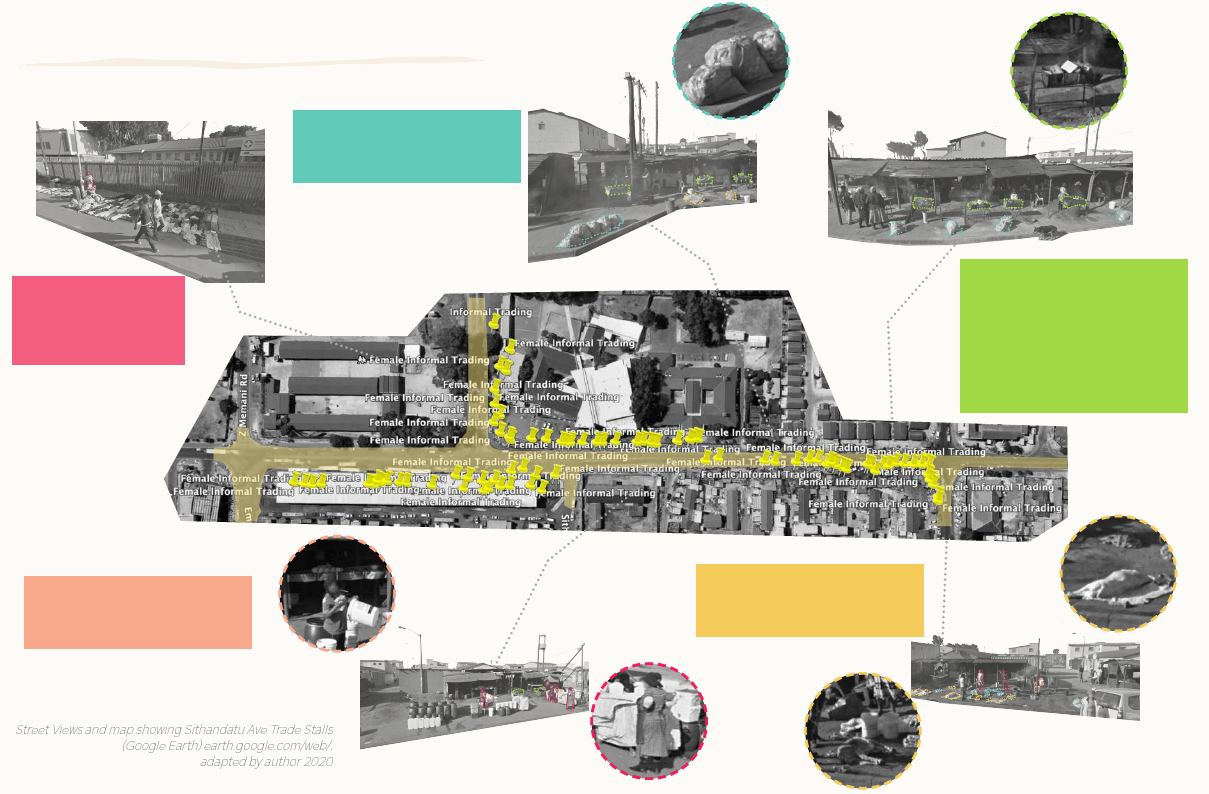
The Stalls| needs assessment
The images on the right highlight a few
issues but primarily speak to the lack
of disposing facilities in the area where
traders leave rubbish along the edge of
the street (making the area untidy).
The image above highlights
the issues in the trading stalls
with regard to lack of seating
for vendors. This is an issue
that is constant throughout the
trading node.
.................
..............
The image above primarily speaks to the
method of cooking used in the trading
stalls. The traders use and open flame
which is kept alight throughout the
day (Niyobuhungiro, 2017). This is not
sustainable and a lot of time it wasted
to keep the fire going and a lot of money
spent on wood. This highlights the need
for a new method of cooking or more
economical ways of sourcing fire wood.
The images on the right highlight the
need for water for cleaning supplies and
workspace as well as the need to seating
for vendors who trade in the space
throughout the day.
Street Views and map showing Sithandatu Ave Trade Stalls
(Google Earth) earth.google.com/web/.
adapted by author 2020
The images on the right highlight the
issues around lack of slaughtering
facilities, where animals are slaughtered
along the street edge and the waste
scattered around the area.
35
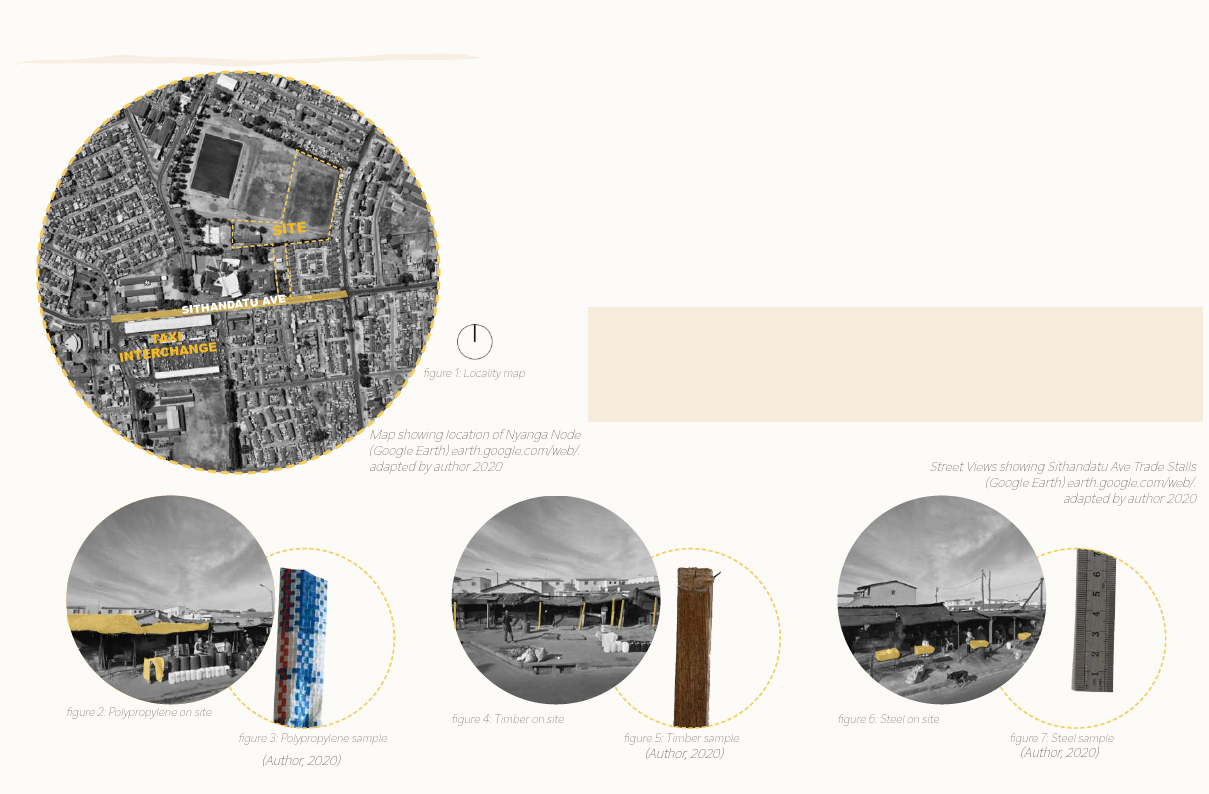
Materials Study| conditions
SITE
SITHANDATU AVE
INTETRACXHIANGE
figure 1: Locality map
This materials study looks at these “self-build” materials and the way that they have been re-used and re-
purposed to create the stalls. This sheds lights on the type of materials that are easily accessible around
the area and conditions of the spaces the women occupy in Nyanga.
For the study, the type of materials found on site were sourced and tested to gain an understanding of the
nature and performance of these materials. This will be discussed later in the study.
These materials are:
1. Polypropylene (which has been used as a shading/covering element as seen in figure 2)
2. Timber (which has been used as a structuring element as seen in figure 4)
3. Steel (which has been used mostly for its ability to hold/withstand fire as well as a structuring and
covering element as seen in figure 6).
In order to understand the material and how it performs on the site, a few tests were conducted
on sample materials. These tests were based on the conditions experienced the site such as: heat
exposure from the sun, heat exposure from fire (as fire is used in and around the stalls for cooking),
friction and bending (as these are harsh conditions, these materials have many forces exerted upon
them and there are many people moving through the space).
Map showing location of Nyanga Node
(Google Earth) earth.google.com/web/.
adapted by author 2020
figure 2: Polypropylene on site
POLYPROPYLENE
,-------.................. . . . .
\\
\\
\\
\\
\\
I
I
I
I
I
I
I
I
, , ,,I I
__ , ,,"'"'
figure 3: Polypropylene sample
(Author, 2020)
figure 4: Timber on site
TIMBER
.,,.-------
.....
\\
\\
\\
\\
\\
I
I
I
I
I
I
I
_, ,,,,, ,,,,II
figure 5: Timber sample
(Author, 2020)
Street Views showing Sithandatu Ave Trade Stalls
(Google Earth) earth.google.com/web/.
adapted by author 2020
figure 6: Steel on site
STEEL
......
''\\
\\
\\
\\
\\
I
I
I
I
I
I
, , ,,,I I
...
_____
__
,
,
,
'
,'
figure 7: Steel sample
(Author, 2020)
36
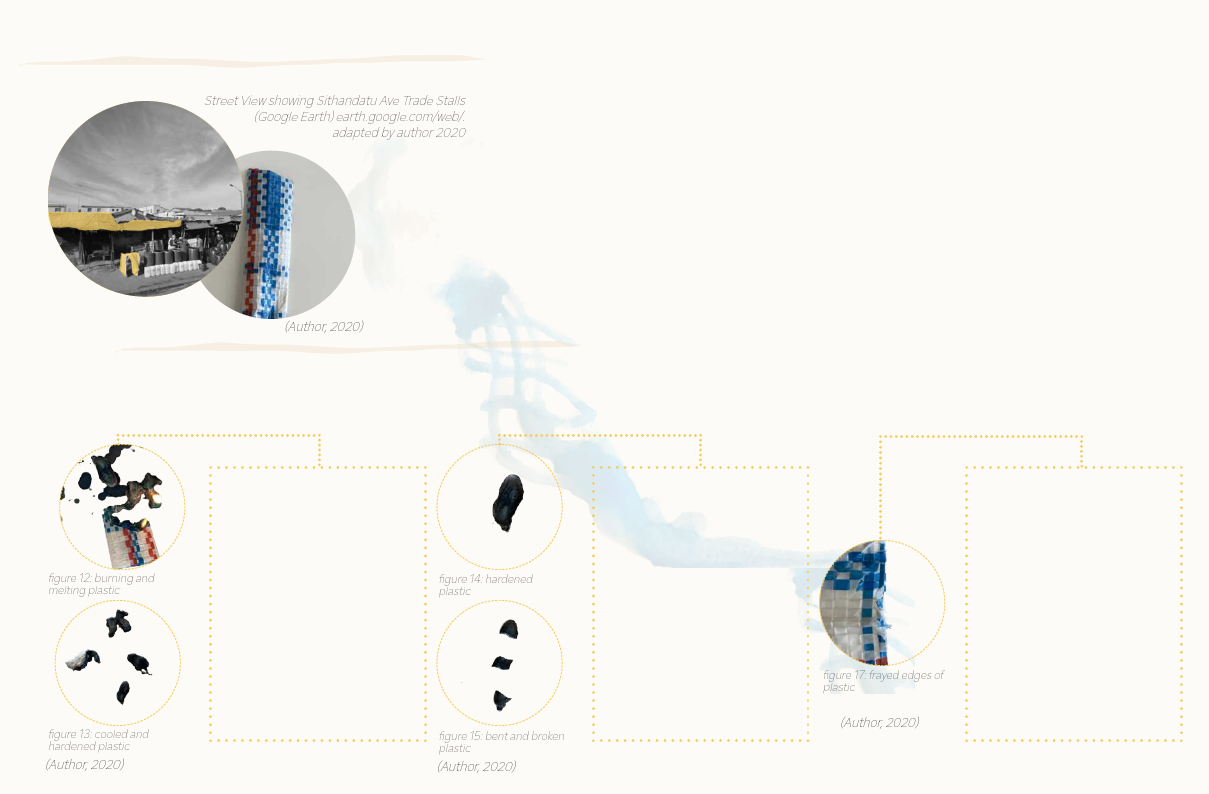
Materials Study| polypropylene
SOURCING
Street View showing Sithandatu Ave Trade Stalls
(Google Earth) earth.google.com/web/.
adapted by author 2020
HOW IT IS SOURCED ON SITE:
(Author, 2020)
This is a packaging material and is used to
package potatoes and onions etc and so it
could sourced from the commercial hub.
Polypropylene bags (used for packing/
travelling) are also sold in the transport
hub. This material could also be sourced
from nearby trash cans/junk collection
points around the area.
NATURE AND PERFORMANCE
.........................................
...... ...............................
,.figure 12: burning and
melting plastic
,·
',
/
''',
',
'·
figure 13: cooled and
hardened plastic
.............................
BURNING
This material insulates heat and so it
,
will not transfer the heat from the sun.
This means that the conditions in the
stalls could actually be cooler. This
material however, has a low melting
temperature of about 250-290 ℃.
The temperature of the simple flame
figure 14: hardened
plastic
of a candle is about 1000 ℃ and so
it will begin to melt when exposed to
4
fire. This material can also catches
fire quickly and easily. This is a hazard
•
as the fire will quickly and easily move
through the area. The fire does not
stop burning until the material has
completely melted.
.............
figure 15: bent and broken
plastic
........................ .
BENDING
When presented as a woven plastic
sheet, as found on site, this material
has no real structure of its own and
will bend in any direction easily and
without breaking.
If the material were to be heated,
melted and remoulded to create
new forms it would harden and
become a lot more rigid (as shown
alongside). In this form however, the
material becomes brittle and will
/
break more easily.
figure 17: frayed edges of
plastic
(Author, 2020)
(Author, 2020)
(Author, 2020)
............................ .
FRICTION
When the material is exposed to
friction (either by the materials
moving against each other or
people stepping on or moving
against it) it will begin to fray. The
polypropylene found and used on
site is woven and so, it will begin to
unravel as it begins to age making it
not very durable.
37
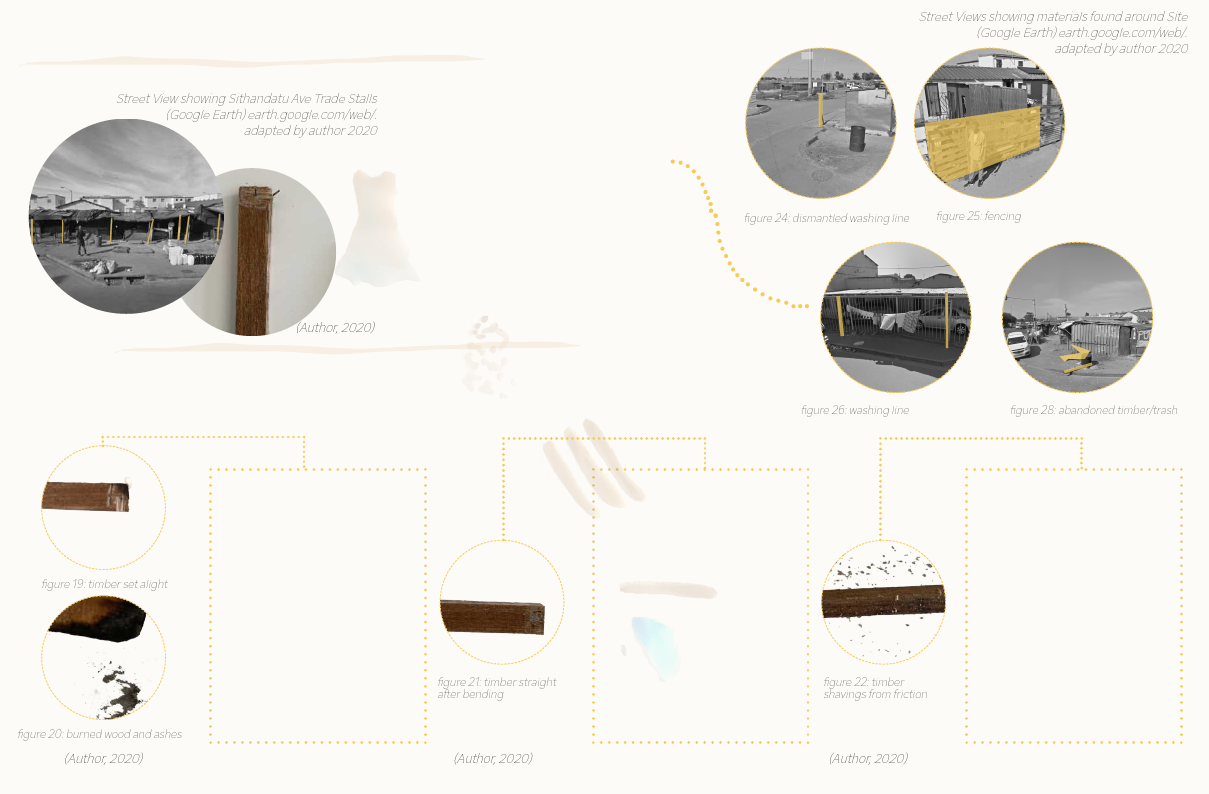
Materials Study| timber
Street Views showing materials found around Site
(Google Earth) earth.google.com/web/.
adapted by author 2020
SOURCING
Street View showing Sithandatu Ave Trade Stalls
(Google Earth) earth.google.com/web/.
adapted by author 2020
HOW IT IS SOURCED ON SITE:
Timber planks look as though they have been sourced
from the hostels in the background. Many of th•e•
washing lines have been made using the same type
of timber used in the support structure of the stalls
and so some of these lines may have been dismantled
to make the stalls. This is also the same timber pole
used on the electric and telephone poles which may
have been chopped and carried to site. The timber
may have also been taken from fencing used in the
house nearby or from trash around the area.
•
•••••••••••••••••f•ig•u•re•2•4•:•dismantled
washing
line
(Author, 2020)
figure 25: fencing
NATURE AND PERFORMANCE
.........................................
....
BURNING
/
,'
figure 19: timber set alight
figure 20: burned wood and ashes
(Author, 2020)
This material insulates heat and so
it will not transfer the heat from the
sun. This means that people will not
burn when they touch the material
on hot days. This material has a
burning temperature of about 300-
600 ℃ and so it will begin to combust
when exposed to fire. This material
can catch fire however, a weak fire
can easily die without spreading very
far. The presence of wind can reignite
the flame and give it strength and it
would spread across the area.
figure 21: timber straight
after bending
(Author, 2020)
....................
,..
BENDING
figure 26: washing line
figure 28: abandoned timber/trash
.. . . . . . . . . . . . . . . . . . . . . . . . . . . . . . . . . . . . . ..
...
FRICTION
This material can bend with a
lot of force exerted and it will
eventually break. This is relatively
strong material and is very difficult
and, depending on its size, can
be impossible to break without
machinery. When bent (before it
reaches its breaking point) it will
immediately return to its original
form.
figure 22: timber
shavings from friction
When the material is exposed to
friction it begins to wear down
and become smaller and weaker.
This is force would have to be very
intentional in order to cause a lot of
damage quickly and so this material
has the ability to last a long time if
treated and maintained well.
(Author, 2020)
38
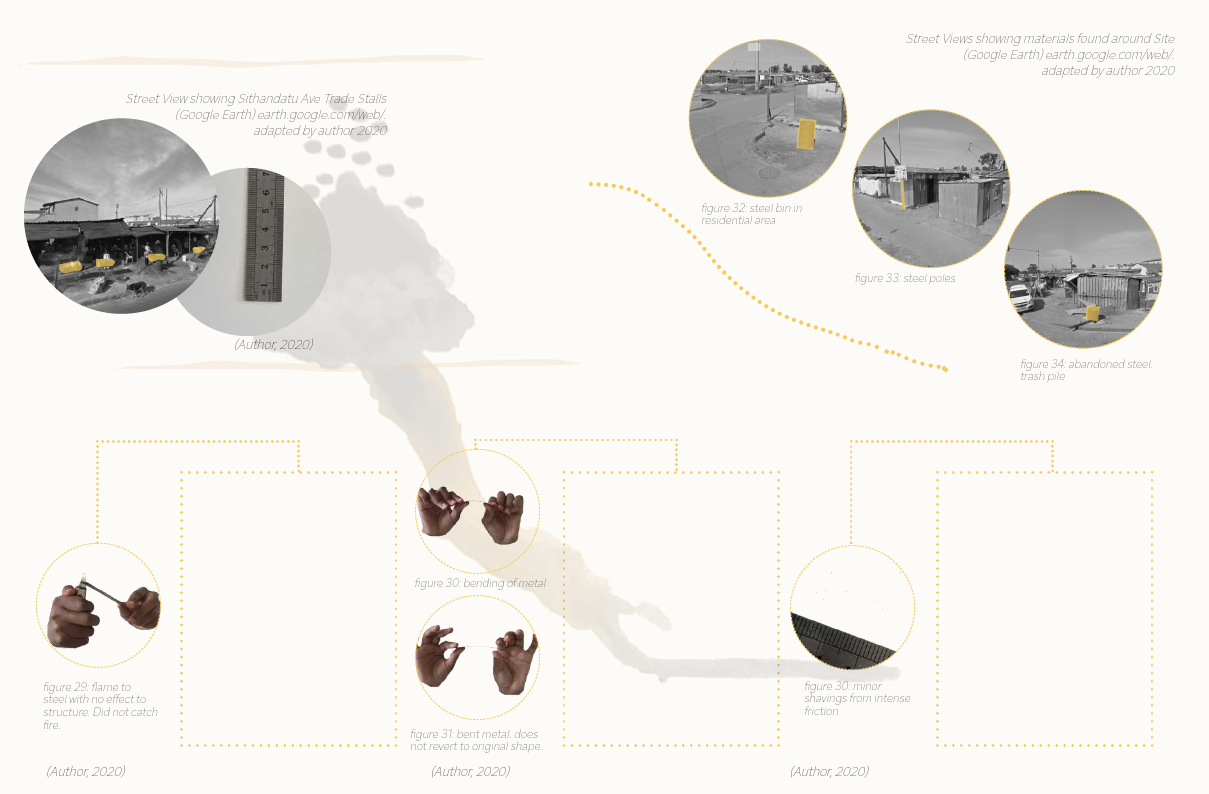
Materials Study| steel
SOURCING
Street View showing Sithandatu Ave Trade Stalls
(Google Earth) earth.google.com/web/.
adapted by author 2020
Street Views showing materials found around Site
(Google Earth) earth.google.com/web/.
adapted by author 2020
(Author, 2020)
NATURE AND PERFORMANCE
HOW IT IS SOURCED ON SITE:
.. ••••• ·•
The braais have been made from steel
barrels (these are usually used as bins in
the area). The braai stands have been made
from the frames of tables which could have
been taken from the nearby schools and
community facilities. The poles (used as
structuring elements) look like they have
been taken from signage around the area.
..... •
•••••••rf•ieg•s•ui•dr•ee•n3•t2•ia:•sl•at•ere•e•al b•i•n
in
••
•
•
••
••
figure
••••
33:
•••
steel
••
poles
figure 34: abandoned steel.
trash pile
. .......................................
................. ............
BURNING
.. __
....
,._ __
.--..
.
.
.
.
.
.
.
.
.
.
.
.
.
.
.
.
.
.
.
.
.
.
.
.
.
.
.
.
.
.
.
.
.
.
••••••••••••••I•••••••••••••
BENDING
. ...................................... .
..............................
FRICTION
figure 29: flame to
steel with no effect to
structure. Did not catch
fire.
(Author, 2020)
This material conducts heat and
so it will transfer the heat from the
sun. This means that touching this
material during a high temperatures
would burn humans. This material
however, has a very high melting
temperature of about 1371-1540 ℃.
The structure of this material would
not change when exposed to fire. This
material could be used as a container
for fire but would not do well an
element that people would have
to touch (such as seating, exposed
structuring elements etc).
figure 30: bending of metal
figure 31: bent metal. does
not revert to original shape.
(Author, 2020)
When bent, the material will not
revert to the original shape, instead
it will take on a new shape. It needs
to be manipulated in order to get it
back to its original shape (either by
putting pressure on both sides in
order to get it to be straight again,
beating/hammering it or bending it
back in the opposite direction).
figure 30: minor
shavings from intense
friction
(Author, 2020)
When the material is exposed
to friction it might retain a few
scratches. When exposed to
extremely high friction, the material
could begin shaving off a little.
However it would be difficult and
would take time without machinery.
39
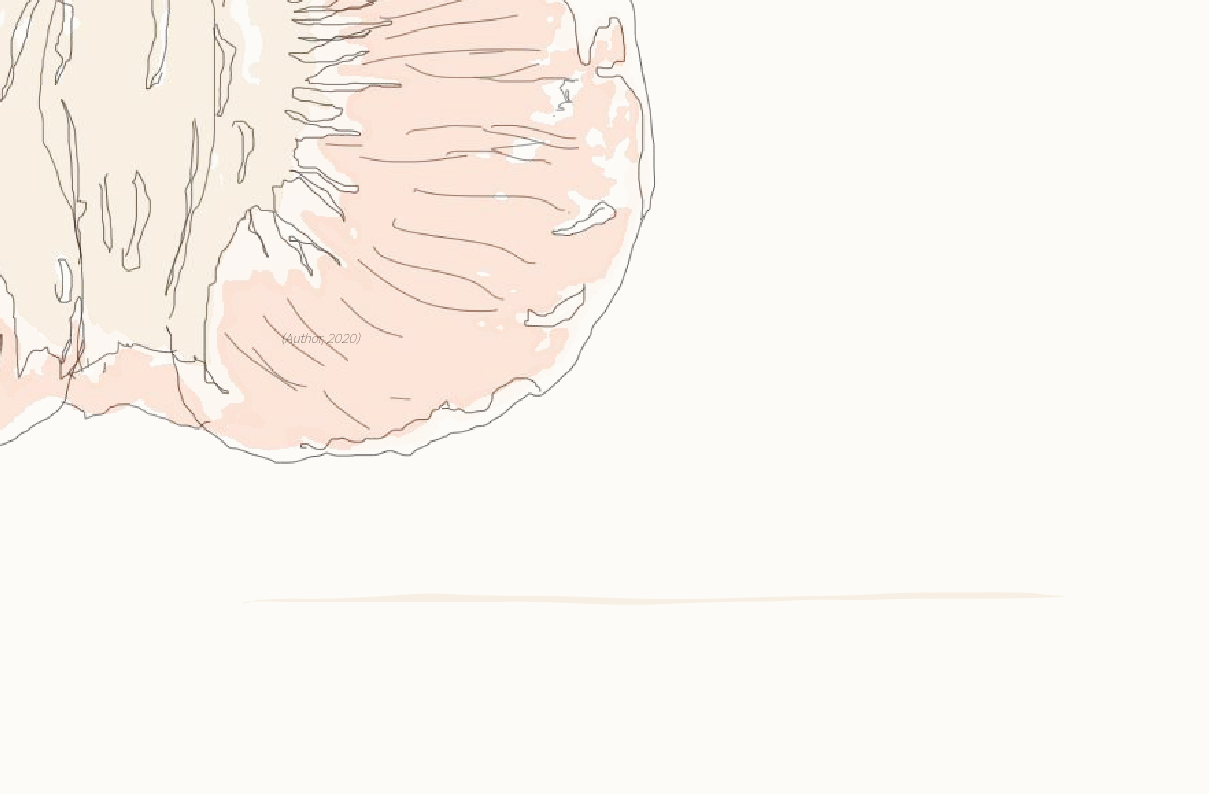
F ~ ~ " ' - - .
-- :::::::::---__
- - - ..___
~
(Author, 2020)
'~
.
.
'"-- - .,,_____O
DESIGN STUDY|
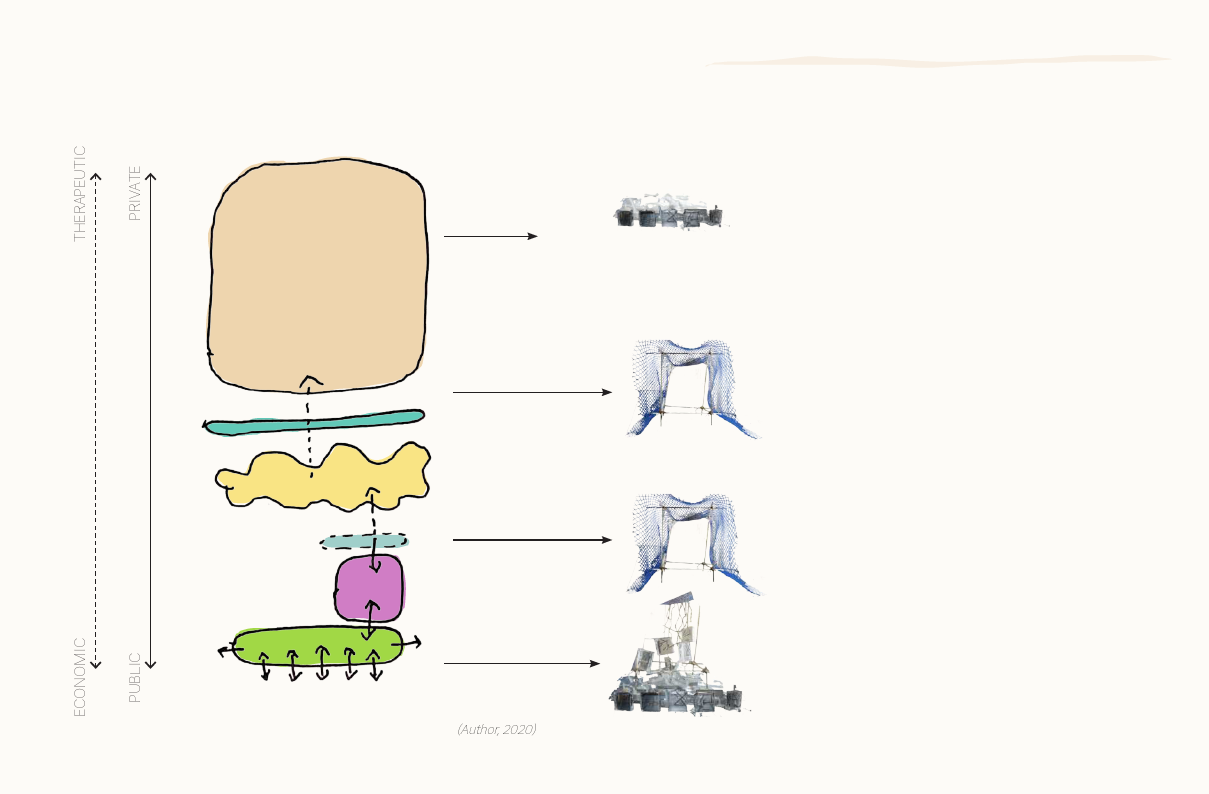
sEii7ZT
WOMXN SPACE +
PLACE OF HEALING
BUFFER ZONE TO
FILTER
BUFFER ZONE TO
FILTER
SPACE FOR
REPRESENTATION AND
EMPOWERMENT OF
WOMXN -
THE MOMUNENT
(Author, 2020)
Conception| diagram
The image alongside is a concept diagram which shows the progression
of space starting from the street (Sithandatu Avenue) which is a
completely public space. These spaces can be used as spaces of
empowerment seeing as this is a visual practice which takes place within
the public realm and is completely accessible (both physically a visually).
This then moves into the vegetable garden (Abalimi Bezekhaya) which
acts as a pseudo-public space (pink area). This space has some of the
qualities of a public space such as the ability for anyone to move in and
out of the space but it has one point of entry. This act of garden in this
space begins to become a method of calming and healing however, in
this zone the economic benefits of the food supply is the main focus.
The two next spaces (indicated in light blue and yellow) becomes a
buffer zone and can be referred to as a state of liminality. The zone
starts to restrict movement and filter the types of people using the
space where more womxn occupy the next space than men. This zone
is still considered part of Abalimi but would have edible indigenous and
endemic plant species. This is a semi- public space where the act and
processes of garden is a form of healing.
The turquoise space becomes the next important threshold/buffer
zone which restricts access to the next space further.
The last space the most private and therapeutic zone. In this space
there will be more introverted activities for healing such as meditation,
prayer, small group sharing circles where womxn can process their
emotions and have space to think begin to heal. The plants in this
space are more medicinal plants harvested for and by womxn as they
need. The space will have plants which can be used to make calming
teas as well as medicinal plants which can be used to help with bruising
and pain. In this space mental and physical healing are at play. This is a
sensory space where the processes of nature connect people to nature
and act as a healing agent.
41
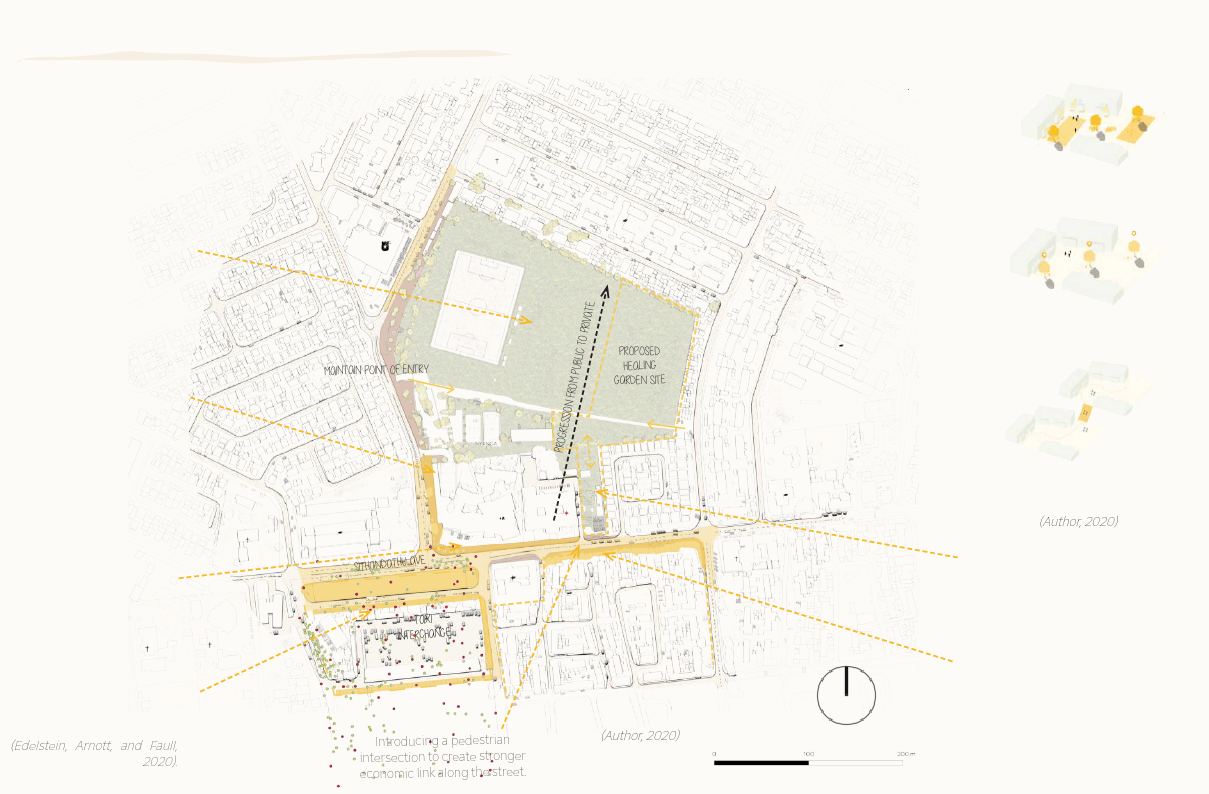
Framework Plan| Opportunities and Constraints
TOOLS
This family park would
need to be formalised,
introducing well integrated
spaces that feed into the
community’s needs.
With the re-purposing of
some of the park space
for the healing garden,
it is important to provide
improved spaces for the
community.
·.)
d; ~
1 r_
__:;J\\~
,
~
~rif}~ti
.... ....
(\\I
Low vegetation to ensure
visibility.
0
g
These stall spaces are stepped
too far from the street and so
traders do not use them as
much. They prefer to trade
closer to the street in order
to catch consumers walking
along the street edge.
MAINTAIN POINT OF ENTRY
I
I
I
I
I
I
I
I
I
I
I
I
I
I
PROPOSED
HEALING
GARDEN SITE
Trees used as shading in
gathering areas. Adds legibility
_.,
These spaces could be
converted to storage space for
traders to leave their goods or
equipment overnight.
,,
'
l'''.'"'HI
Change of road texture to pedestrianise
the street and connect activities.
l I /1
./ (I t j ' I I I;·
I
(Author, 2020)
J"' .~ _;_ Removal of community
centre fence to give more
fI
-----------__-.-.._-,
I ll
.I. -
--
~SITH-A..N-.D.A..T_HU
AVE
women a chance a chance to
trade within the node.
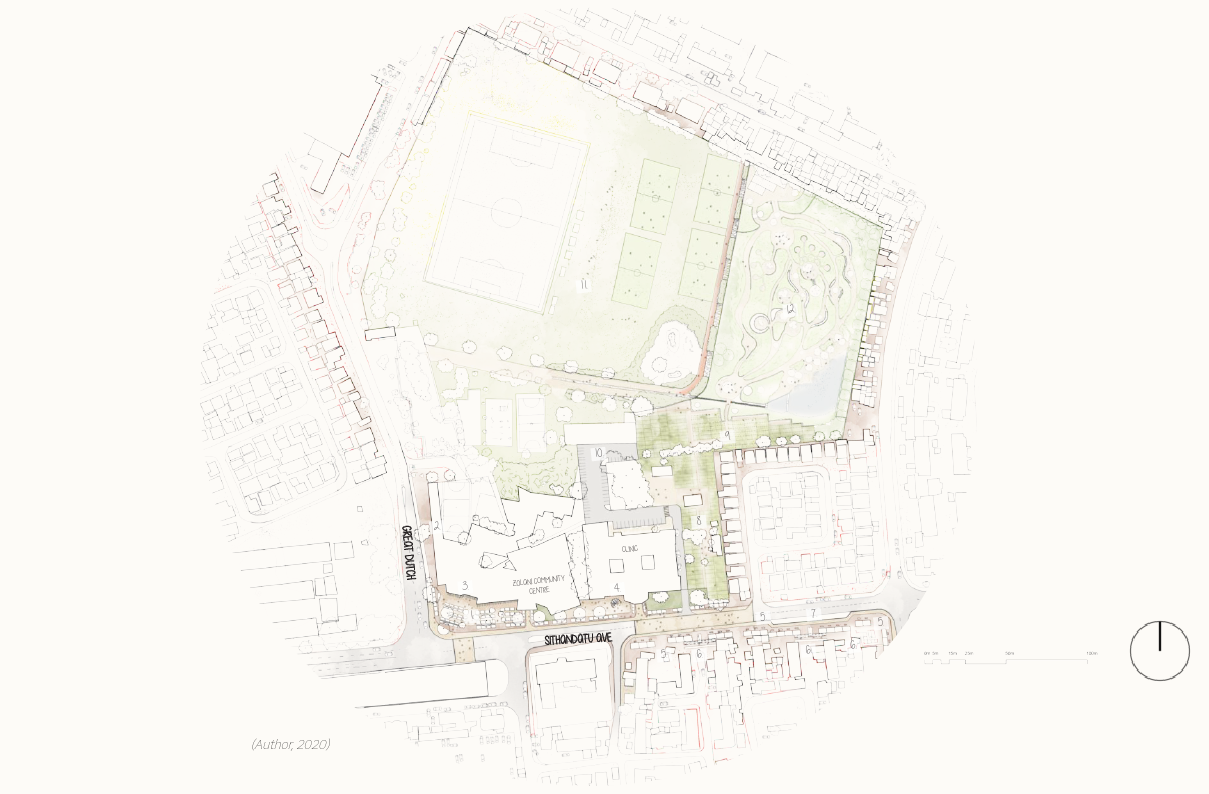
j,,_
I
,J
,j
.. ~
I'
I
·~
" - ·. ~
f Y' \\
rI'
,.. . 7 __)
I
~
'''
\\
' -_) .,.. .- .
c=:J .,,..
;>
I
- .~
I\\
\\'
~\\
,.--
' --,\\_
/ ~___,
!,
·D
~
r,
2.
3.
1.
'
.r <'
..
-
' ~~ ~~
t
•I ,
11.
. J1 V ) .( .,.•. .·,/") \\
f' (I,.
I
I·.
I
r? 12.
i
9.
10.
8.
CLINIC
ZOLANI COMMUNITY
CENTRE
4.
SITHANDATU AVE
5. 6.
5.
7.
5.
6.
6.
1. TRADERS MARKET
2. TRADERS STORAGE
3. PROTEST WALL
4. ODE TO WOMXN
5. FORMALISED FOOD TRADING STALLS
6. SLAUGHTER FACILITIES
7. GOODS DROP-OFF ZONE
8. ABALIMI (WITH EXPANSION)
9. ABALIMI (INGENIOUS)
10. ADDITIONAL PARKING
11. FAMILY PARK
12. HEALING GARDEN
- ,HlOm
(Author, 2020)
I'
'I
tI
II
Framework Plan
43

The image on the preceding page is the final framework plan.
TRADERS AND ECONOMIC EMPOWERMENT (EAST)
The fence of the Zolani Community Centre has been taken down
with bits of the lower brick wall remaining to act as seating for traders
in the market space. The old Zolani Centre parking lot will be used
as a market space. Vendors from Great Dutch Street can now move
down into the main trade node and trade within the market space.
The old trade stalls will be converted to storage space for vendors
to put equipment and goods overnight (this will make their morning/
evening commute to work easier as they will have less to transport
each day). Parking has been added (behind the day clinic) to replace
the parking removed from the Zolani Centre and a pathway between
the clinic and community centre will connect them.
TRADERS AND ECONOMIC EMPOWERMENT (WEST)
The trade stalls on the west will be rebuilt and formalised. The former
structuring elements will be re-used to create an artwork within the
healing garden. The introduction of slaughter facilities behind the
stalls would also be needed to ensure that the slaughter activities do
not disturb the trade activity taking place along the main spine. The
drop-off zone will be used for delivery of sheep, chicken and offal
cooked on-site.
MOVEMENT HIERARCHY AND CONNECTIVITY
Cobble-paved intersections would be introduced to slow down
traffic and pedestrianise the main road. These intersections would
allow for interconnectivity between the trade stalls; making it easy
for consumers to move between the different stall types and linking
food traders with the farming activity taking place in the Abalimi
Gardens. Different types of paving will be used for the trader zones
and the pedestrian walkways to limit disrupted movement and
activity between the pedestrians and vendors.
MONUMENTS AND WOMXN EMPOWERMENT
The Zolani Centre facade facing the Taxi Interchange would be
turned into a protest wall. Art related to GBV events taking place
within and around the community would be painted or projected on
this wall. This would encourage discussions within the community
around GBV issues taking place.
A skeleton-dome structure will be added as a shading structure for
women waiting for doctors’ appointments. This structure will have
figures representing local womxn (create by a local artists) which
would eventually be covered by creeping plants.
ABALIMI FOOD PROVISIONING AND BUFFER ZONES:
The Abalimi gardens would be extended to give more womxn the
opportunity to trade and source food for their families. Currently,
Abalimi uses well/borehole water to irrigate the plants and so more
water would be needed for this activity. This would be done buy
introducing groundwater recharge interventions in and around the
space.
Some of the extension would include edible indigenous and
endemic plant species. Cape Fynbos plant species can survive on
normal rainwater cycles and so little to no additional water would
need to be provided for this area.
The farming and gardening activity in Abalimi would add surveillance
and a layer of safety to the entrance of the healing garden (much
like the entrance of the day clinic which is almost guarded by female
traders along the space).
FAMILY PARK: TAKING AND GIVING BACK TO THE COMMUNITY:
Some of the family park space would be used to introduce the
introverted healing garden for local womxn in Nyanga. To balance
this, additional spaces would be added to the remaining family
park in order to make this area more functional and safer for the
community to use.
There would be covered gathering/picnic areas for families to use.
These would overlook four 5-a-side soccer fields for community
soccer players and leagues to use as practice space, play areas for
smaller children which would join to the existing play spaces. The
road family park would be pedestrianised and cars would be left in
the existing parking lot.
THE HEALING GARDEN: THE SPONGE
The healing garden would act as a sponge for Nyanga, with the
introduction of SUDS such as bioswales, wetland systems, planting
and permeable paving. This would cleanse the rainwater and also
encourage aquifer recharge to balance the farming activity and
water-use in the Abalimi Gardens.
44
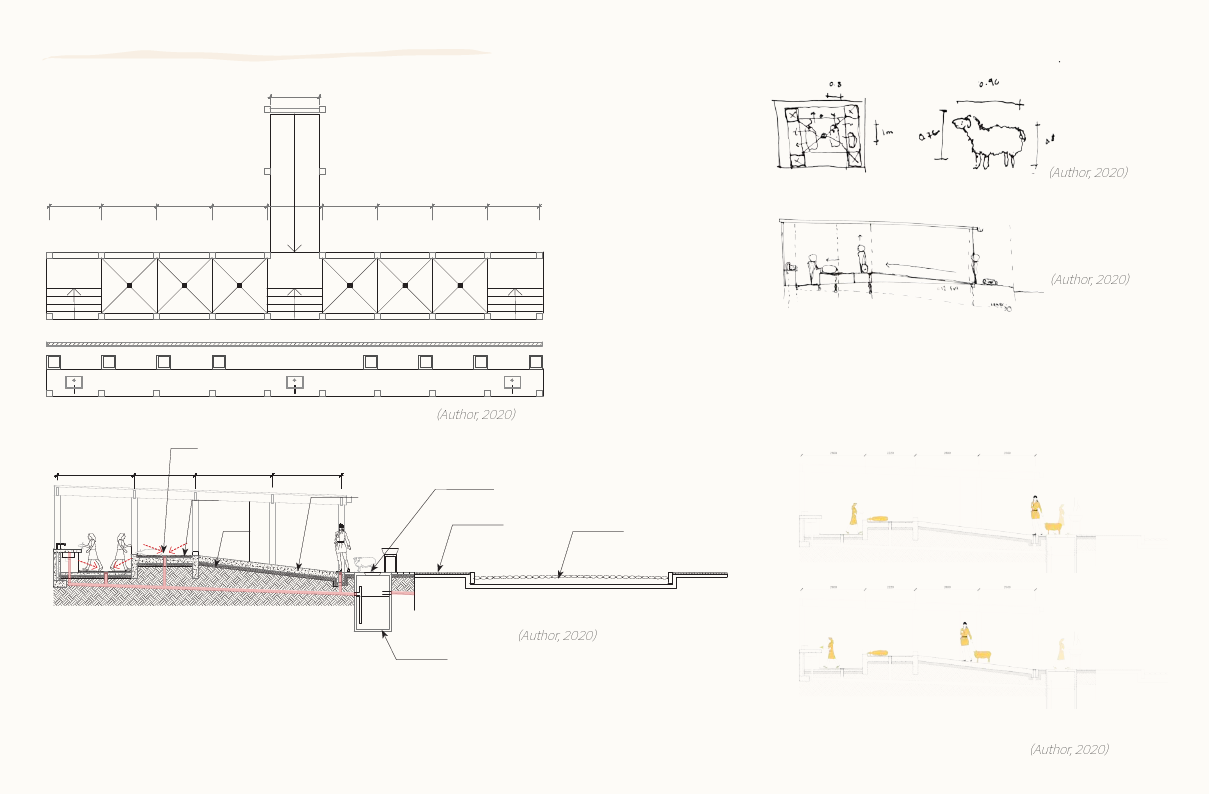
The Stalls| slaughter facilities
11778800
1780
RAMP UP
□
□
1890
2000
2000
2000
2000
2000
2000
2000
1890
889900
22000000
22000000
22000000
22000000
22000000
22000000
22000000
11889900
□
PLAN
22880000
+0.6m
+0.6m
+1.0m
+1.0m
SLAUGHTER AREA
□
2800
22222200
CIRCU+L0A.7TmION SPACE
+0.7m
0.0m
0.0m
□
□□□
+0.8m
+0.8m
(Author, 2020)
COUNTER SPACE
150x150mm
stainless steel drainage
2220
2800
22880000
22550000
50mm screed to
fall (2%)
150mm hadcore
layer
2500
230mm concrete
ramp sloping at
1:12, with a polished
finish
600 dia manhole cover (for
maintance acces)
cobble walkway.
raised cobble
pavement
to sewer
sewerage
sewerage
SECTION
grease trap
grease trap
grease trap
(Author, 2020)
All water drained within this zone would be contaminated (from slaughter activity) and
would need to be directed to the sewer system after passing through a grease trap.
This area would need to be covered to avoid mix of stormwater and contaminated water.
UNDERSTANDING NEEDS FOR THE SPACE
(Author, 2020)
(Author, 2020)
To assist with some of the slaughter activity need, a minor slaughter
activity could be introduced. The surfaces would be polished concrete
to allow for quick and easy clean and limit any waste and contaminants
sticking to the space. Bins would be provided for each section to
encourage a clean work space. A ramp would be used to carry the
animals into the space. Municipal water would be needed to clean the
space and use would need to be monitored.
j
l
TT
DIAGRAMS SHOWING SLAUGHTER-ZONE USE AND
CONNECTION TO STREETS
(Author, 2020)
45
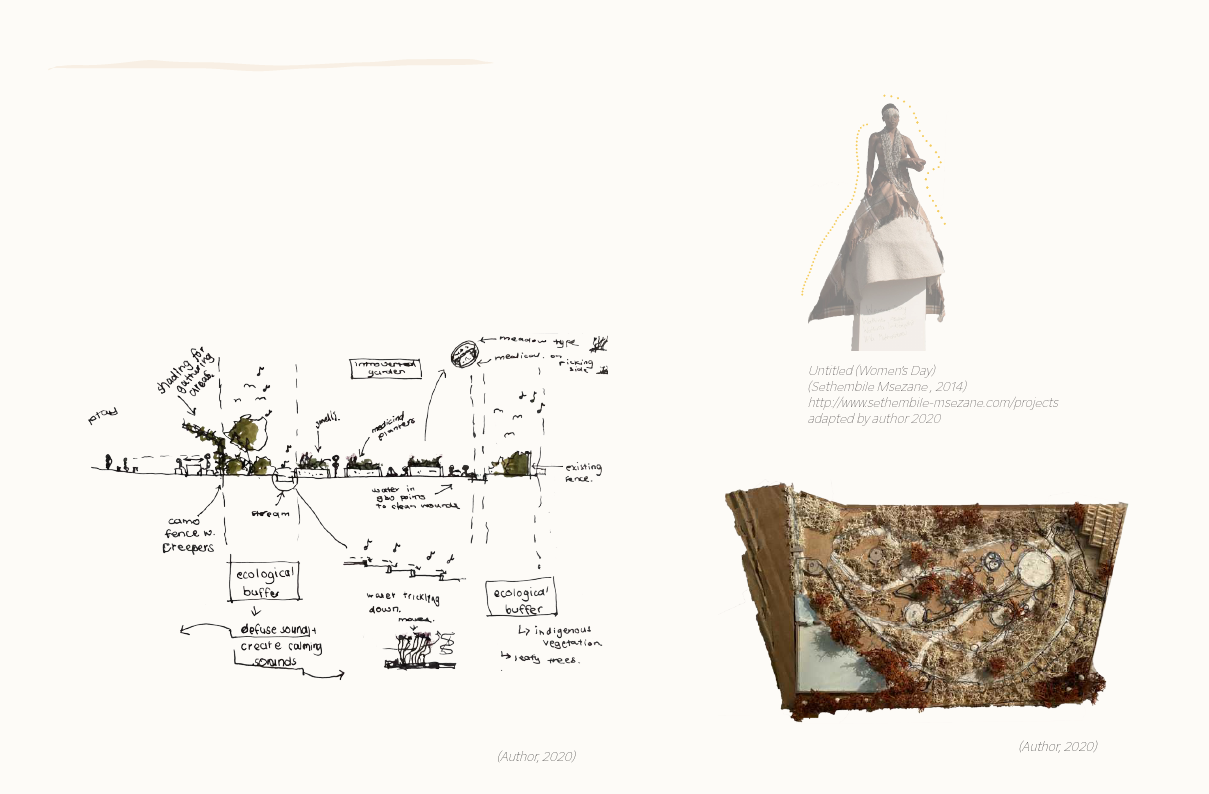
The healing garden| Concept
This garden would make use of a lot of soft landscaping (planting) and organic
forms to mimic the features of the female form. Earthy tones (clay reds and
light sandy browns) would be used for the hard landscaping to give garden
a more natural feel. Vegetation would play an important role and patches of
medicinal and endemic plant species would be used in the space to guide
draw certain users to specific spaces. Lower vegetation would be used for the
middle zones and higher vegetation along the edges to act as a buffer from
surrounding activities.
ec.o I c.9·1 c<1 I
bufft.1
'¥
~;
~ c rQo~ e <:Cllfl'li'.9
"'cu~~ tr,ue\\t
, <(O<.Ut1. ,,__',_3
i/!fJ
CONCEPTUAL SECTION
L-~ i..,6i~~ov,1
I.;.
vesc_-\\"G<.i(G"'-
1~ ~1!..S.
(Author, 2020)
FORMS AND TEXTURES
//
Untitled (Women’s Day)
(Sethembile Msezane , 2014)
http://www.sethembile-msezane.com/projects
adapted by author 2020
CONCEPTUAL MODEL
(Author, 2020)
46
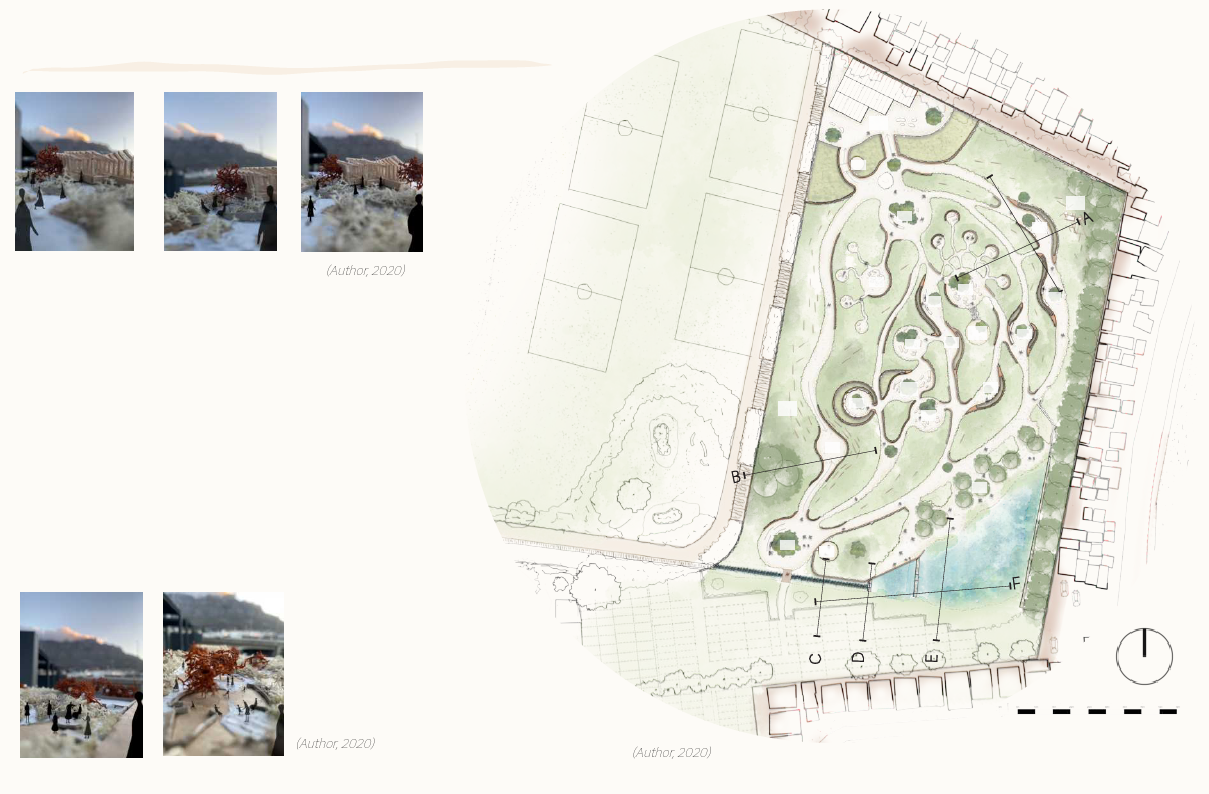
The healing garden
GREEN HOUSE
1. ENTRANCE AND INFORMATION BOARDS
2. PODIUM
3. GATHERING AREA
4. PAUSE AREA
5. TEEN AREA
6. ELDERS AREA
7. MIDDLE-AGED WOMXN/TRADERS AREA
8. GBV AREA
9. TRADITIONAL HEALERS AREA
10. CHILDREN AREA
11. GREENHOUSE
12. ARTWORK
(Author, 2020)
ENTRANCE + PODIUM CHILDREN
(Author, 2020)
FAMILY PARK
.
.
3.
.
4.
A
.
.
4.
4.
.
. 4.
4.
.
4.
.
.
.
.
B
.
.
.
ABALIMI
(INDIGENOUS)
)~- ✓
. ". J . \\.' J'\\,'
(Author, 2020)
F
-----
Plan
47

This is an experiential garden consisting of meandering routes (to allow for
reflection and contemplation), smelling, tasting and harvesting (gardening
activity) of medicinal plants, gathering zones with spaces for discussions
(linking womxn with similar life events and experiences together so that they
can begin to support one another) as well as art created by the womxn to
reflect their journey of healing in the space.
The entrance of the space has information boards about the plants, their uses
and where to find them and the different meeting areas.
The healing garden would have space for different types of womxn and uses.
The more “every-day” spaces for elders, teenagers and middle-aged womxn
and traders would be closer to the entrance with planting directed to their
needs. Some of the womxn using these spaces may not have care-takers for
their children and so a zone has been allocated for them. This space would be
between close to the other zones so that the guardians can address issues
related to each zone (i.e. everyday teen issues or issues faced by traders/
middle-aged womxn and elders) whilst still looking over their children.
There would be larger gathering areas for local womxn to meet and discuss
community matters collectively as well as minor pause spaces.
There would be spaces community traditional healers to meet as well as
breakaway spaces for them the meet with and assist local womxn.
A green house would be introduced to help with propagation of medicinal
plants harvested in the area.
Podiums would be introduces at three point of the site (the beginning, middle/
greenhouse zone and the end of the journey). These would be vantage points
for womxn to look over the entire garden. When on these podiums, the womxn
would also become living sculptures for a moment.
48

The healing garden| GBV Spaces
BREAKAWAY SPACE
BREAKAWAY SPACE
BREAKAWAY SPACE
MAIN AREA
KIDS
INFO WALL
BREAKAWAY SPACE
BREAKAWAY SPACE
(Author, 2020)
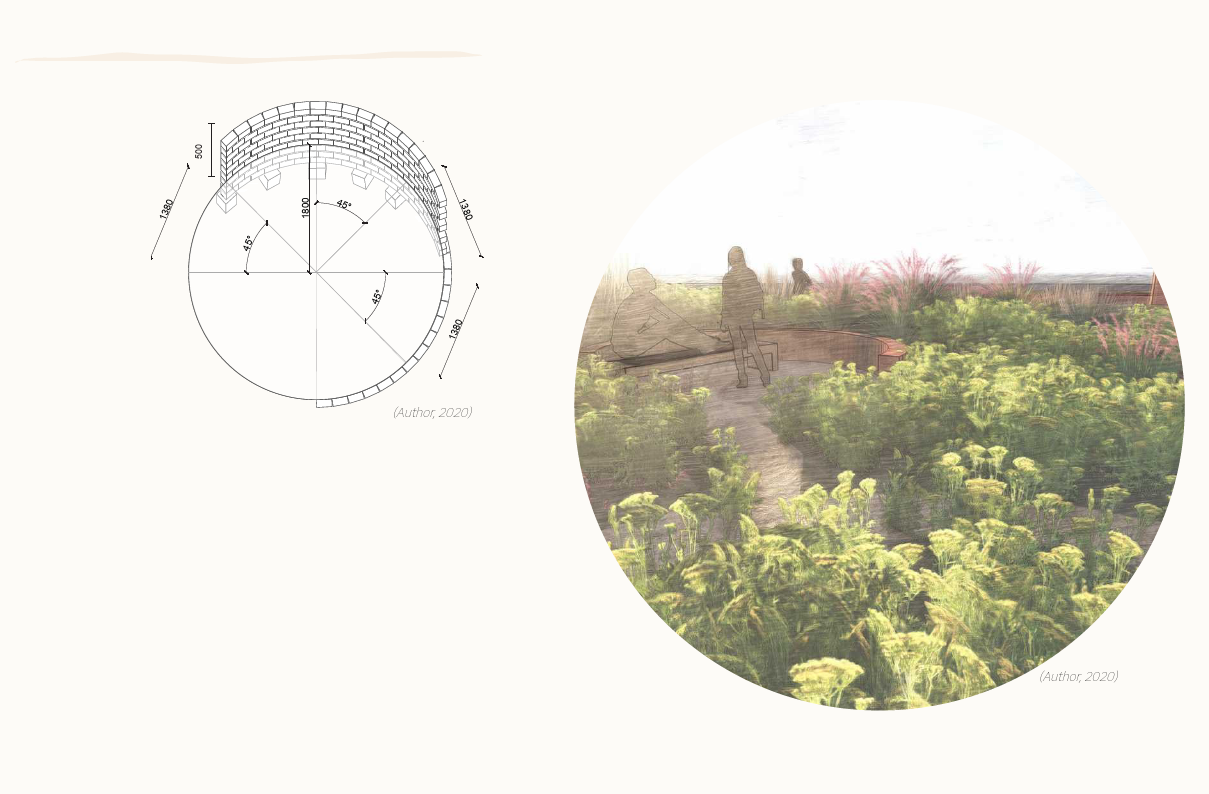
The healing garden| GBV Spaces
45°
BREAKAWAY SPACE AXONOMETRIC
(Author, 2020)
The area for womxn who have experienced gender-based violence in
the community would have a main area for minor group discussions and
counselling. The wall around this area would have information and steps to
take when dealing with GBV events (i.e documentation, opening cases and
reporting of the event).
This area would also have breakaway spaces for private meetings, meditation
or prayer, and consultations for these womxn (these can be seen on this and
the preceding page).
Lastly the area would have a space for children to stay in while these other
activities take place. The planting around this area would mostly be directed
at healing of wounds and aiding with mental health (such as the Cancer Bush
which helps with anxiety and depression).
(Author, 2020)
PERSPECTIVE OF BREAKAWAY SPACE WITH HELICHRYSUM ODORATISSIMUM IN THE
FORGROUND AND LESSERTIA FRUTESCENS AND TECOMARIA CAPENSIS IN THE
BACKGROUND.
50
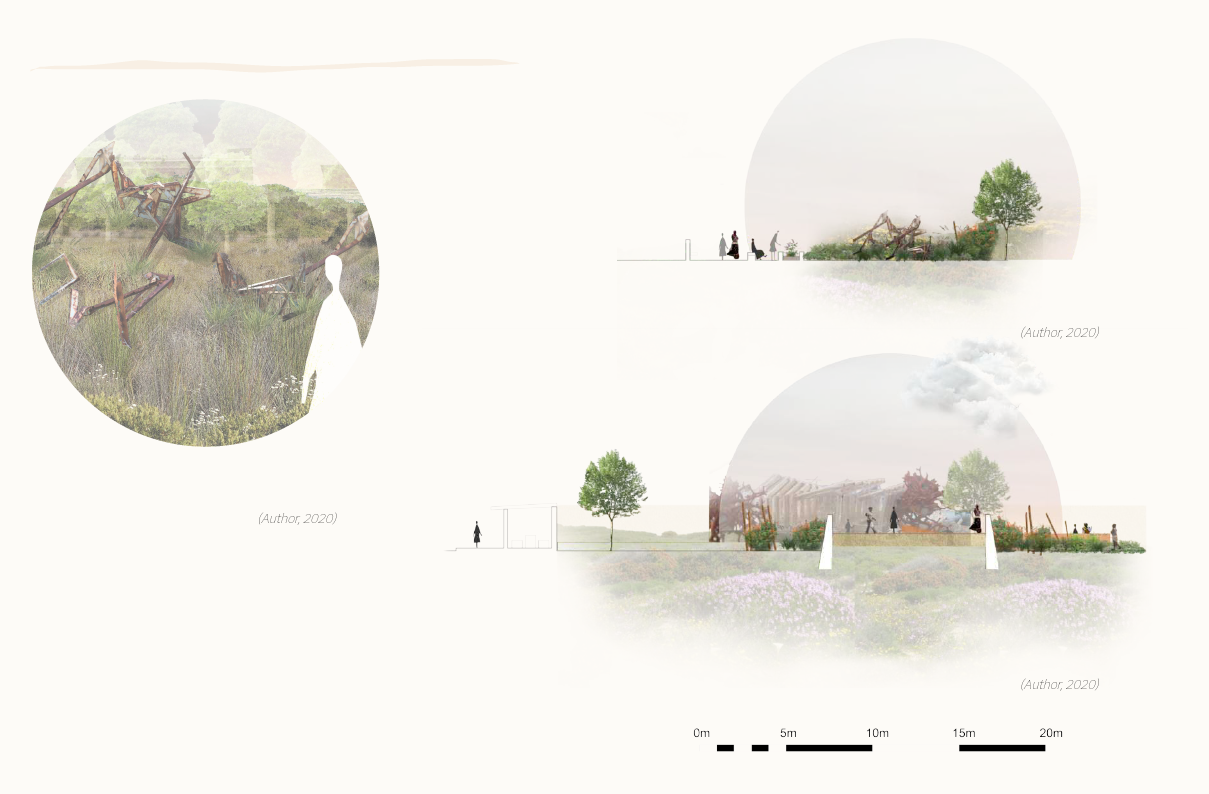
The healing garden| Artwork
SECTION A SHOWING THE CHAOTIC ARTWORK
(Author, 2020)
PERSPECTIVE OF CHAOTIC ARTWORK
(Author, 2020)
There would be an artwork created by the local womxn
using the old structuring elements of the food stalls
which would represent the healing process. Starting with
a chaotic assembling of the elements to show the initial
mental state and need for support (with the structures
leaning on one another for support) and then ending
with an army of these structuring elements standing on
their own, independent and empowered.
l • r
SECTION B THROUGH PODIUM SHOWING THE EMPOWERED ARTWORK
(Author, 2020)
- - Om
5m
10m
15m
20m
51
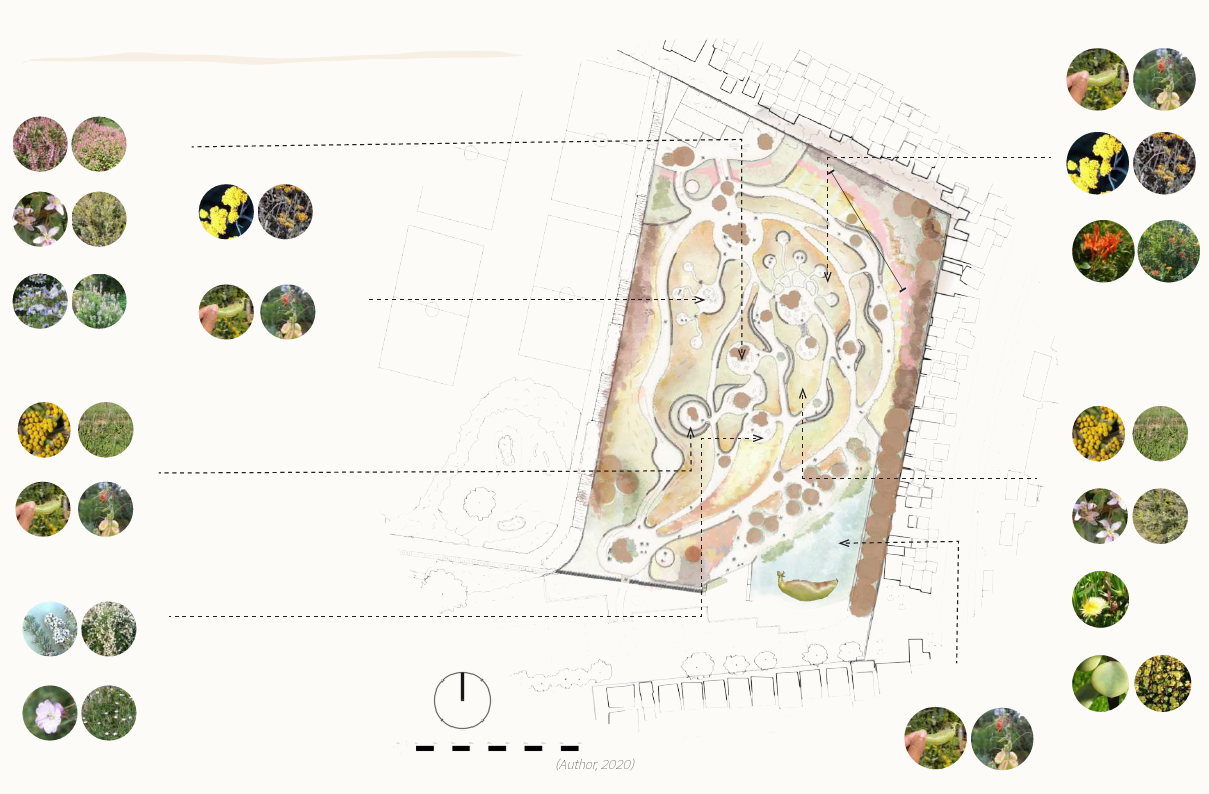
The healing garden | Gradient mapping
DAY-TO-DAY (STORE):
Uses:
Wash sheep
skin
These are not the only uses of the
plants but the main use in each
space/reasons for allocations.
PLECTRANTHUS FRUTICASUS
TRADITIONAL HEALERS:
Uses:
Swelling of legs
(standing long
hours)
Uses:
Calming
incense
AGATHOSMA CRENULATA
(BUCHU)
HELICHRYSUM ODORATISSIMUM
(IMPHEPHO)
SALVIA AFRICANA
(BLUE SAGE)
Uses:
Colds
Uses:
- - - .:..
Healing
properties
LESSERTIA FRUTESCENS
(CANCER BUSH)
DAY-TO-DAY (ELDERS):
_,}
----
Uses:
Joint pain, bruises, swelling
t -·
HELICHRYSUM NUDIFOLIUM
: _~------ _______________________________________
(WILD EVERLASTING)
Uses:
Inflammation, backache, calming
(, ',
(J
,~·
,)
I ART
/
LESSERTIA FRUTESCENS
'---
(CANCER BUSH)
DAY-TO-DAY (TEEN):
Uses:
Menstrual cramps, cold
ERIOCEPHALUS AFRICANUS
(WILD ROSEMARY)
'\\
- ,. J
GERANIUM INCANUM
(CARPET GERANIUM)
Uses:
Regulate menstrual cycle,
bladder infections
-----
(Author, 2020)
~ (-,
' . ;,>"-."
✓ ~ .. ~
..... ,._ •• .,..
...· . . ' ',...
GREENHOUSE
MEETING AREA
MENTAL HEALTH:
Uses:
Anxiety and
depression
LESSERTIA FRUTESCENS
(CANCER BUSH)
'
--- ~---------------Uses:
Calming
incense
r
HELICHRYSUM ODORATIS-
ART
SIMUM (IMPHEPHO)
Uses:
Calming tea
TRADITIONAL
GBV
TECOMARIA CAPENSIS
(CAPE HONEYSUCKLE)
TRADERS
ELDERS
KIDS
TEENS
WOUNDS:
Uses:
Bruises,
swelling
GATHERING AREA
___________ :_ __
HELICHRYSUM NUDIFOLIUM
(WILD EVERLASTING)
'Uses:
Heal slow-
healing
wounds
AGATHOSMA CRENATA &
BETULINA (BUCHUS)
WATER PLAY:
Uses:
Flower used for play by
children near waterbodies
(floating, racing games)
Uses:
Antispetic,
soothing,
healing
Uses:
Antiseptic,
soothing
CARPOBROTUS EDULIS
(SOUR FIG)
PORTULACARIA AFRA
(SPEKBOOM)
52
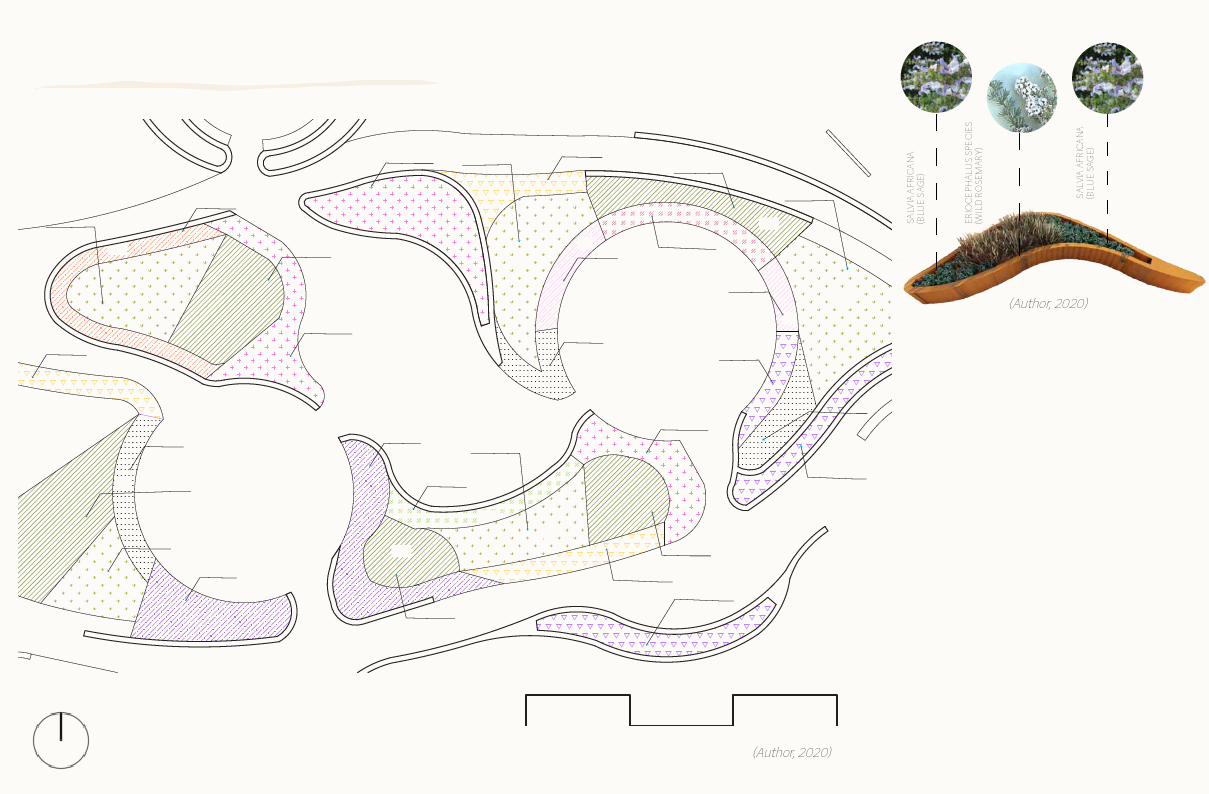
Planting plan and Plant uses
MIX 3
12m2
18m2
HO
7m2
EA
4m2
MIX 2
30m2
11m2
MIX 3
15m2
&-------------·
MIX 1
MIX 3
HN
18m2
MIX 2
20m2
15m2
MIX 1
KIDS
7m2
20m2
6m2
HO
5m2
AC
MIX 2
7m2
PF
MIX 3
13m2
AC
MIDDLE AGE/
3m2
EA STORE OWNERS
SA
5m2
GI
MIX 3
12m2
MIX 1
8m2
TEENS
GI
10m2
PA
9m2
16m2
MIX 3
15m2
8m2
12m2
12m2
MIX 3
HO
SA
11m2
27m2
EA
SA
0M
5M
10M
15M
(Author, 2020)
(Author, 2020)
The planting would be low to medium height
planting (maximum 1.2m-1.5m) in the centre of
the site and that is indicated by the lighter colours
used in the garden’s gradient plan with the higher
vegetation along the edges to acts a visual buffers
from the adjacent activities and buildings.
Specific plants would be used around different zones
to tackle issues that those womxn could be facing.
Around the teen area would mostly be plants like the
Geranium incanum and the Eriocephalus species
which are known to help with menstrual cramps in
irregular cycles, while the plants in the elders area
would help with joint pains, colds and coughs, the
area for the middle aged womxn/store owners would
have plants they can use to clean sheep skin (which
can be used to make a carpet or resold) and plants to
help with body aches from day-to-day tasks.
Plants which help with mental health would be
scattered around the zone and could found in each
zone but would be found in bulk around the GBV
area (where womxn have experience trauma) as well
as plant for wounds.
53
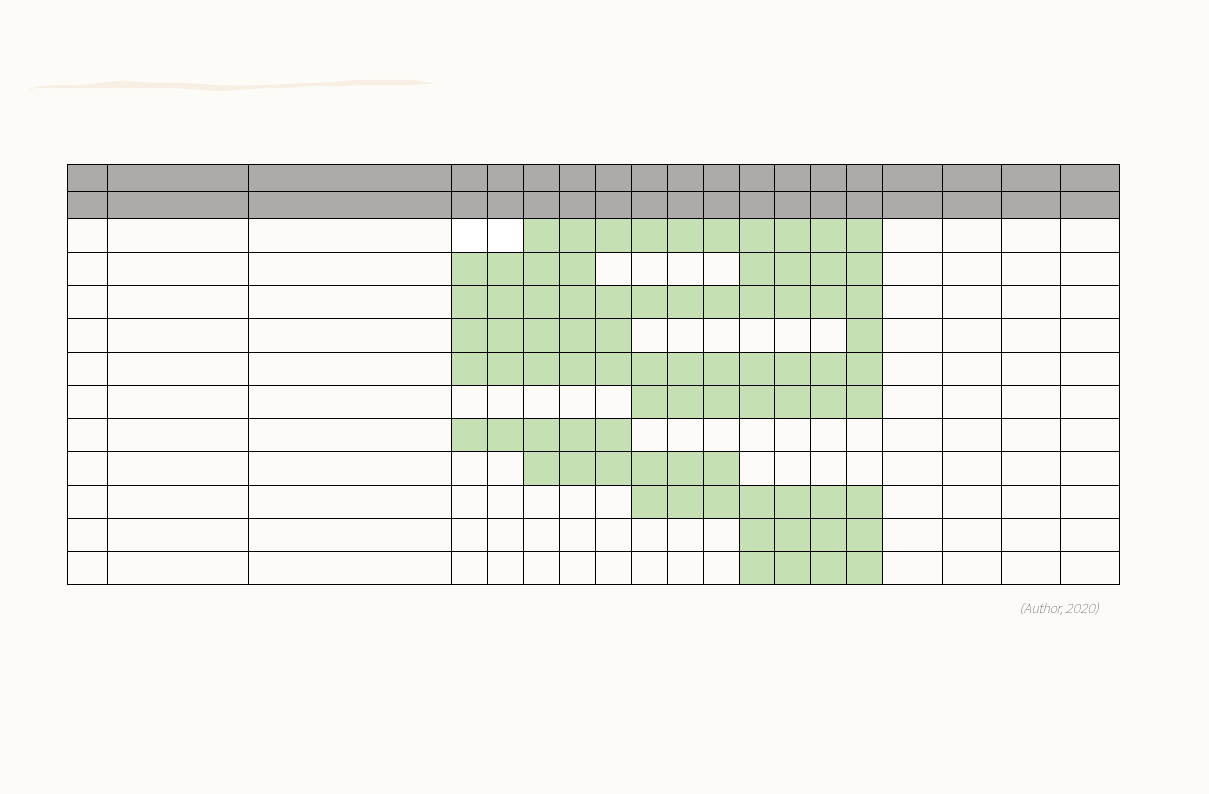
Planting plan and Plant uses
Planting List
Key
Mix 1
Mix 2
Mix 3
HN
Name
Salvia africana-caerulea
Eriocephaius africanous
Felicia filifolia
Cliffortia obcordata
Athanasia dentate
Pelargonium betulinum
Tarconanthus camphoratus
Helichrysum nudifolium
HO
Helichrysum odoratissimum
AC
Agathosma crenulata
PF
Plectranthus fryticosus
EA
Eriocephaius africanous
SA
Salvia Africana-caerulea
PA
Portulacaria afra
GI
Geranium incanum
Uses
sore throat, voice loss
coughs, cold, colic, inflammation
endemic species - stablises dunes, improves soil quality
endemic species - stablises dunes, improves soil quality
bruises, swelling, rheumatic joints
calming
rheumatism, kidney, indigestion, bladder
wash sheepskin & cotton garments
coughs, cold, colic, inflammation
sore throat, voice loss
sores, spots, stings
regulate menstruation, bladder infections
Total
J
F
M
A
M
J
J
A
S
O
N
D Area (m2)
Size
Density
(Units/m2)
Quantity
47
4kg
4
188
61
4kg
4
244
113
4kg
4
452
12
4kg
4
48
22
4kg
4
88
8
4kg
4
32
7
4kg
4
28
18
4kg
4
72
28
4kg
4
112
9
4kg
4
36
31
4kg
4
124
(Author, 2020)
54
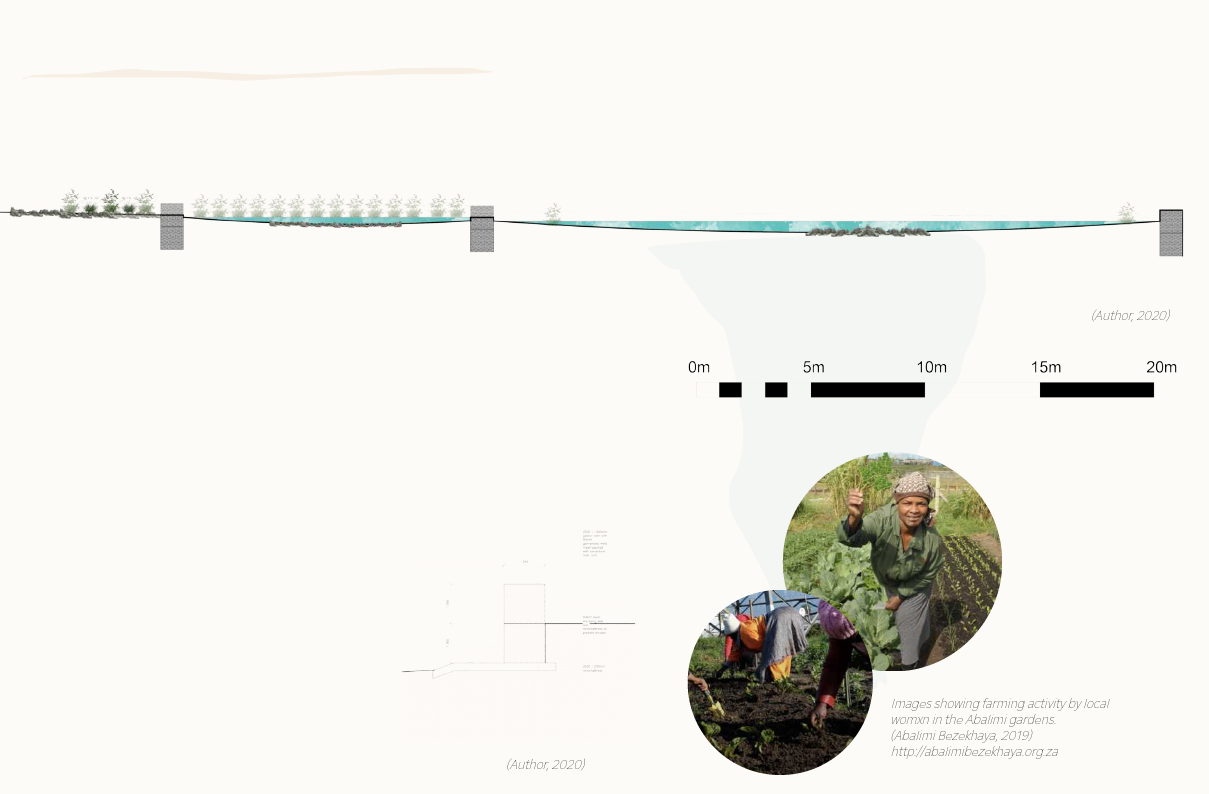
The healing garden | Recharge
OXYGENATION
SEDIMENTATION
MAIN RECHARGE
FACTOR OF SAFETY (FOS) CALCULATIONS FOR
GABION RETAINING WALL
Ka = (1-sin(phi of soil)) / (1+sin(phi of soil))
= (1-sin(30)) / (1+sin(30))
= 0,5 / 1,5
= 0.3
Pa
= Ka x y x H
= (0.3 x 16kN/m3) x 1,5m
= 7,2
Md
=1/2 Pa x H x 1/3H
= (1/2 x 7,2 x 1,5m) x (1/3 x 1,5m)
= 5,4 x 0,5
= 2,7
MR = Wgab x d
= (2 x1) x 21 x 0,5
= 21
FOS ACHIEVED
Pa
= Ka x y x H
= (0.3 x 16kN/m3) x 1,5m
= 7,2
Md
=1/2 Pa x H x 1/3H
= (1/2 x 7,2 x 1,5m) x (1/3 x 1,5m)
= 5,4 x 0,5
= 2,7
MR = Wgab x d
= (2 x1) x 21 x 0,5
= 21
FOS ACHIEVED
- - Om
5m
(Author, 2020)
Section F
(Author, 2020)
10m
15m
20m
As previously discussed, this
site would act as a sponge to
recharge aquifer water used for
irrigation in the Abalimi gardens
and this would consist of 3
phases.
Images showing farming activity by local
womxn in the Abalimi gardens.
(Abalimi Bezekhaya, 2019)
http://abalimibezekhaya.org.za
55
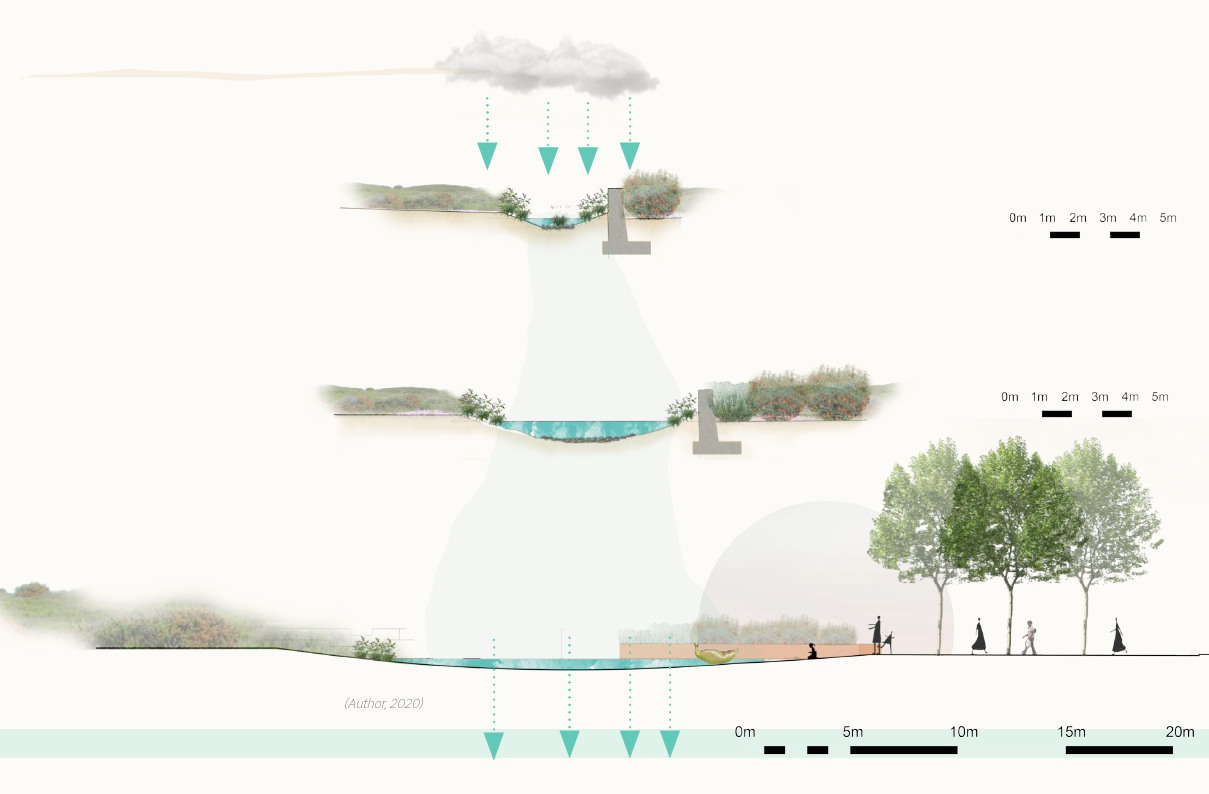
The healing garden | Recharge
THE BIOSWALE:
This would have a stone-covered
sloped bottom/base (which
would carry water down the site
with limited erosion) and plants
(such as the Mentha longifolia)
along the edges.
THE FOREBAY:
This would have a stone-covered
flatter bottom/base to allow water
to slowly filter through into the
ground. The water would stand and
fill up before spilling into the last
waterbody. This would allow for the
sediments to drop.
SEDIMENTATION
THE WETLAND:
This would be a depression
within the landscape that would
collect runoff from the site and
slowly release it into the aquifer.
' '' .
OXYGENATION
Section C
- - Om 1m 2m 3m 4m Sm
- -Section D
Om 1m 2m 3m 4m Sm
AQUIFER
(Author, 2020)
MAIN RECHARGE
- - . .
Om
5m
Section E
10m
15m
20m
56
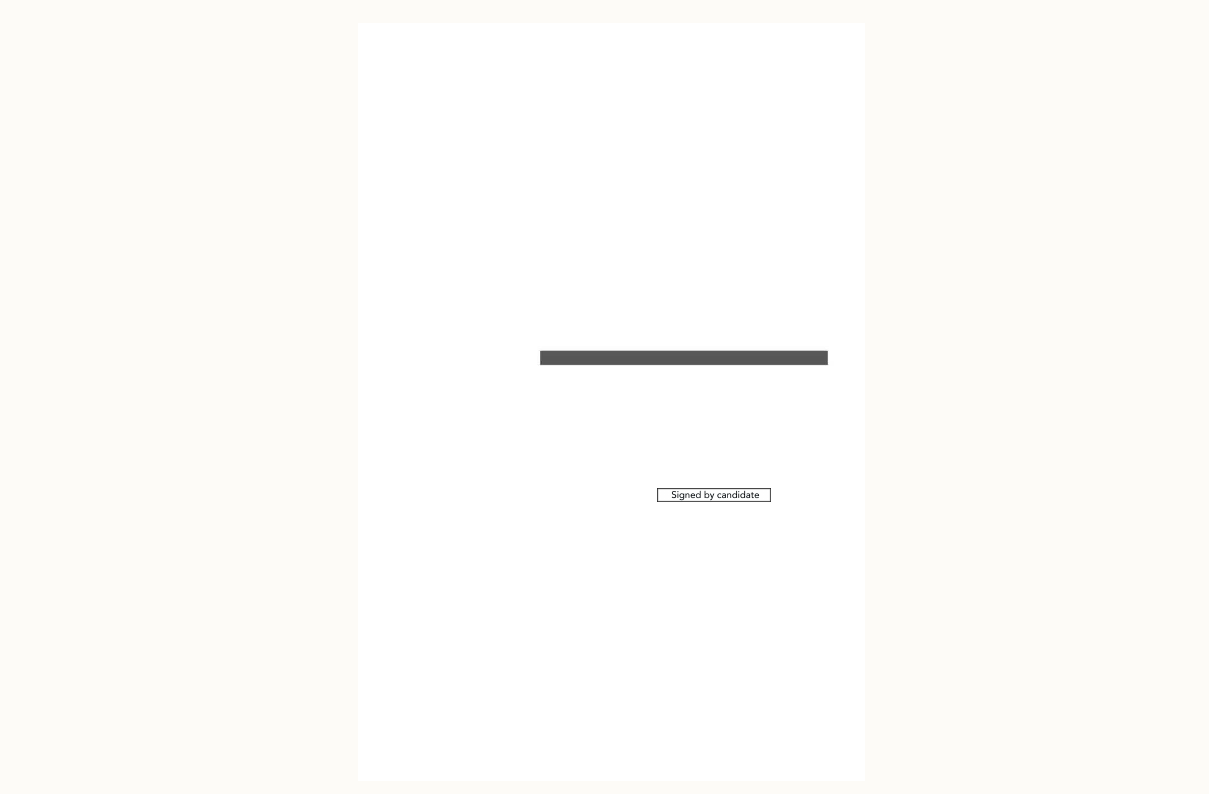
Appl!catlon for Approval of Ethics In Research (EiR) Projects
Faculty of Engineering and the Built Environment, University of Cape Town
ETHICS APPLICATION FORM
Please Note:
Any person planning to undertake research in the Facu lty of Engineering and the Built Environment (EBE) al the University
or Cape Town is required to complete this rorm before collecting or analysing data . The objecttve ol submitting this
application prior to embarking on research is to ensure that the highest ethical standards in research , conducted under the
auspices or the EBE Faculty , are met. Please ensure tha t you have read , and understood the EBE Ethics In Research
Handbook (available from lhe UCT EBE , Research Ethics website) prior lo completing this application
form: http://www.ebe.uct .ac.za/ebe/researchlethlcs1
APPLICANT'S DETAILS
Name of principal researcher, student or
external applicant
Department
Preferred email address or applicant:
Kazeka Talisa Mbekeni
APG
mbkkaz0011@@mmyyuucctt.aacc..za
Your Degree:
e .g ., MSc, PhD, etc.
MLA
Credit Value of
If Student Research: e.g.,
11220
60/120/180/360 etc.
Name of Supervisor (if
supervised):
Christine Price
If this is a resea rchconlract. Indicate the
source of fund ing/sponsorship
ProJect Title
N//A
Creating Healing Spaces for Women in Places of Conflict
I hereby undertake to carry out my research in such a way that:
there is no apparent legal objection to the nature or the method of research; and
the research wil l not compromise staff or students or the othe r responsibilities of the University;
the stated objective wi ll be achieved , and the findings will have a high degree of validity;
lim,tations and alternative interpretations will be considered ;
the findings could be subject to peer review and publicly available: and
I will comply wrth the conventions or copyright and avoid any practice that would constitute plagiarism.
APPLICATION BY
Principal Researcher/
StudenUExtemal applicant
Full name
Kazeka Talisa Mbekeni
Signature
-
Date
Sig ned by candidate I 1155//0066//2020
SUPPORTED BY
Supervisor (where applicable)
Full name
Christine Price
Signatufe
Signatureet,Rfveimc..oev, ed
Date
15/06/2020
APPROVED BY
HOD (or delegated nominee)
Final authority for all applicants who
have answered NO lo all questions in
Section 1: and ror all Undergraduate
research (Including Honours) .
Chair. Faculty EIR Committee
For applicants other than
undergraduate students who have
answered YES lo any of the questions
in Section 1.
Full name
R Behrens
Signature
Date
lr.7~Signature Removed 04 Sep 2020
Page 1 of 1
57
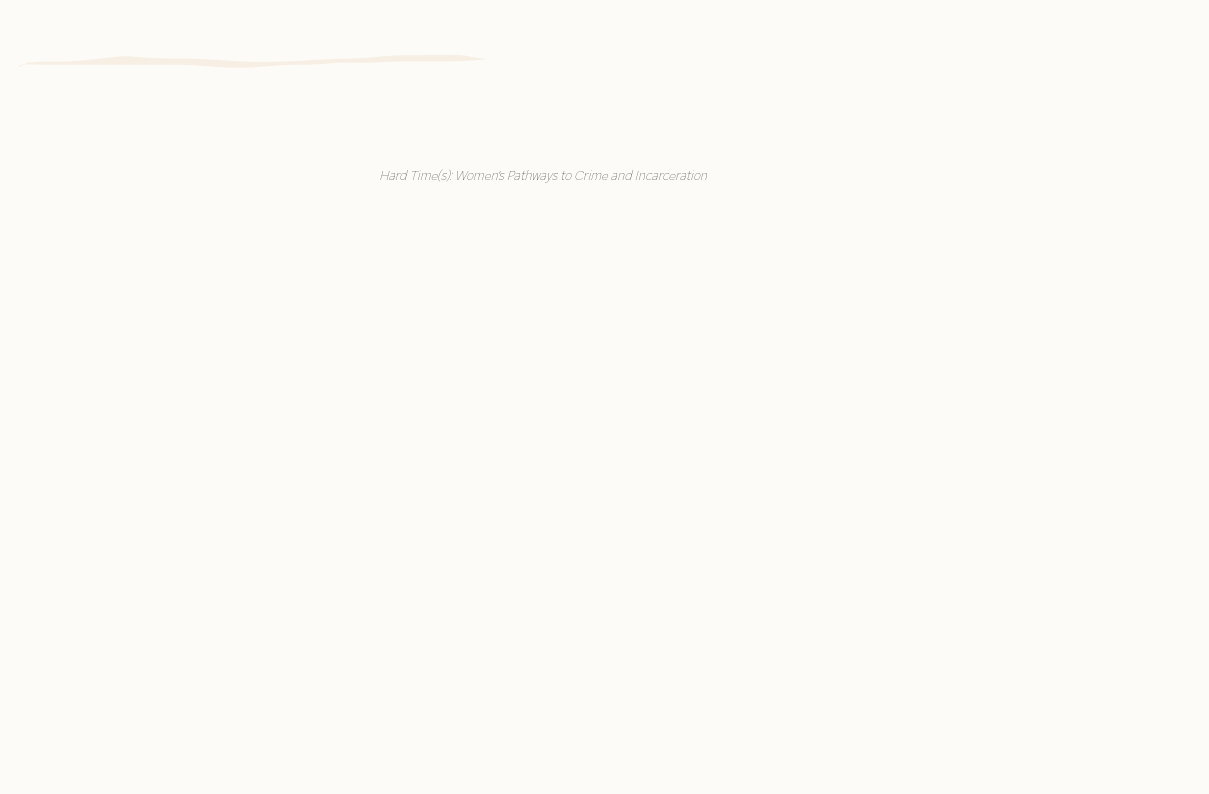
Bibliography |
• Abramson, D. (2020). Make History, Not Memory History’s Critique of Memory. Harvard Design Magazine. Accessed on: http://www.harvarddesignmagazine.org/issues/9/make-history-not-memory
• Anderson, P. and O’Farrell, P (2012). “An ecological view of the history of the City of Cape Town.” In Ecology and Society 17(3).
• Artz, L., Hoffman-Wanderer, Y. and Moult, K. (2012). Hard Time(s): Women’s Pathways to Crime and Incarceration. Cape Town: GHJRU, University of Cape Town. http://detentionjusticeforum.org.za/
wp-content/uploads/2013/09/GHJRU-Hard-Times-Report-on-Women-in-SA-Prisons.pdf
• Barthel, S, Folke, C, and Colding, J. (2010). Social–ecological memory in urban gardens—Retaining the capacity for management of ecosystem services. Global Environmental Change 20 (2010)
255–265
• Brotchie, A. (1991). A book of surrealist games. London: Redstone Press.
• Burton, A. (2014). Gardens that take care of us. The Lancet, 13. doi:http://dx.doi.org/10.1016/S1474-4422(14)70002-X
• Christopher A, S. I., Murray Silverstein. (1977). A Pattern Language Towns, Buildings, Construction. New York: Oxford University Press.
• CS Studio Architects. (2002). Zolani Multi Purpose Centre. Retrieved from http://csstudio.co.za/Xolani.html
• Davis, R. (2015). OPINION: In the realm of SA statues it’s still a man’s world [Press release]. Retrieved from https://ewn.co.za/2015/03/20/OPINION-Rebecca-Davis-In-the-realm-of-SA-statues-its-
still-a-mans-world
• Dee, C. (2001). Form and Fabric in Landscape Architecture: A visual introduction. London: Spoon Press.
• Diepsloot, V. H. (2018). Collecting and using data to help victims of gender violence. Retrieved from http://www.vimbadiepsloot.co.za
• DuBose, J., MacAllister, L., Hadi, K. and Sakallaris, B. (2018). Exploring the Concept of Healing Spaces. . HERD, Vol. 11(1), 43-56. Retrieved from https://doi.org/10.1177/1937586716680567
• Ebbensgaard, C. L. (2017). ‘I like the sound of falling water, it’s calming’: engineering sensory experiences through landscape architecture. Cultural Geographies, Vol. 24(3), 441-455.
doi:10.1177/1474474017698719journals.sagepub.com/home/cgj
• Ebrahim S and Huang J. (2020). Space and Memory. HATLA II: Spatial Practices Seminar.
• Edelstein, I., Arnott, R., Faull, A. (2020). Hotspot policing for murder and robbery: A Cape Town case study. Retrieved from https://www.africaportal.org/publications/hotspot-policing-murder-and-
robbery-cape-town-case-study/
• Fourie, R. (2020). Once we, the women of South Africa, were warriors [Press release]. Retrieved from https://www.iol.co.za/news/opinion/once-we-the-women-of-south-africa-were-warriors-44423220
• Freud, S. (1910). The Origin and Development of Psychoanalysis. American Journal of Psychology. Vol. 21(2), 181-218. Retrieved from https://doi.org/10.2307/1413001
• Gontsana, M.-A. (2015). Slaughterhouse proposed for Nyanga, following SPCA complaint [Press release]. Retrieved from https://www.groundup.org.za/article/proposed-slaughter-site-nyanga_3226/
• de Groot, S. (2020). Not having enough statues of iconic women is a monumental oversight [Press release]. Retrieved from https://www.timeslive.co.za/sunday-times/opinion-and-analysis/2020-08-
02-not-having-enough-statues-of-iconic-women-is-a-monumental-oversight/
• Herrington, S. (2016). Landscape Theory in Design. London: Routledge.
• Hewson, D. (n.d.). Sethembile Msezane. Retrieved from https://artafricamagazine.org/december-2014-sethembile-msezane/
• Isaacs, L. (2018). Tensions High in Nyanga Following Triple Murder of Taxi Officials [Press release]. Retrieved from https://ewn.co.za/2018/10/22/tensions-high-in-nyanga-following-triple-murder-
of-taxi-officials
• Ishmail, S. (2019). PHOTO ESSAY: Exhibition brings statues of Struggle heroes and heroines to Cape Town [Press release]. Retrieved from https://www.iol.co.za/capeargus/news/photo-essay-
exhibition-brings-statues-of-struggle-heroes-and-heroines-to-cape-town-37360936
• Jones, L. V. (2014). Black Feminisms: Renewing Sacred Healing Spaces. Journal of Women and Social Work, Vol. 30 (2), 246-252. doi:10.1177/0886109914551356
• Kent., J. L. (2015). Therapeutic landscapes: an evidence-based approach to designing healing gardens and restorative outdoor space. . Australian Planner, Vol. 52(3), 242-243. Retrieved from https://
doi.org/10.1080/07293682.2014.897638
• Kim Miller, B. S. (2017). Public Art in South Africa: Bronze Warriors and Plastic Presidents. Indiana University Press. Retrieved from https://www.jstor.org/stable/j.ctt20060c0.1
58

Bibliography |
• Krog, S., R. (1983). Creative Risk-Taking. American Society of Landscape Architects. Vol. 73(3), 70-76. Retrieved from https://www.jstor.org/stable/44666665
• Lekekela, B. (2019). Green Door: Information Booklet. In. Johannesburg: Green Door.
• Magazi, T. (2016). Jailed for ‘bag theft’. Retrieved from https://www.vukaninews.co.za/news/jailed-for-bag-theft
• Mahlakoana, T. (2020). Nyanga, Khayelitsha, Diepsloot, Alex among 30 GBV Hotspots in SA – Cele [Press release]. Retrieved from https://ewn.co.za/2020/09/22/nyanga-khayelitsha-diepsloot-alex-
among-30-gbv-hotspots-cele
• Maroga, K. (2017). The Poetics of Remembrance as Resistance: The Work of Sethembile Msezane. Retrieved from https://artthrob.co.za/2017/02/27/the-poetics-of-remembrance-as-resistance-
the-work-of-sethembile-msezane/
• Mehrotra, K. V. a. S. T. (2007). ‘Shall We Go out?’ Women’s Safety in Public Spaces in Delhi. Economic and Political Weekly, Vol. 42(17), 1542-1548. Retrieved from https://www.jstor.org/stable/4419521
• Msezane, S. (2015). Sethembile Msezane. Work. Retrieved from http://www.sethembile-msezane.com
• Niyobuhungiro, R. V. (2017). Investigation of the Applicability of a Cleaner Production Approach to Road Side Catering in Urban Africa. (Doctor of Philosophy). The University of Cape Town, Cape
Town.
• Ntseku, M. (2019). 16 Days of Activism: Triangle Project host event in Nyanga to combat GBV, hate crimes [Press release]. Retrieved from https://www.iol.co.za/capeargus/news/16-days-of-activism-
triangle-project-host-event-in-nyanga-to-combat-gbv-hate-crimes-37963709
• O’toole, S. (2016). Speaking truth to statues [Press release]. Retrieved from https://www.timeslive.co.za/news/south-africa/2016-07-19-speaking-truth-to-statues/
• Olin, L. (1988). Form, Meaning, and Expression in Landscape Architecture. Landscape Journal, Vol. 7(2), 149-198. Retrieved from http://www.jstor.com/stable/43322829
• Pertsovsky, N. (2017). This is probably the list of artworks UCT has removed [Press release]. Retrieved from https://www.groundup.org.za/article/probably-list-artworks-uct-has-removed/
• Polyco. (2016). What are Polyolefins. Retrieved from https://www.polyco.co.za/about-polyco/about-polyolefins/
• Rabeneck, A. (1969). Form Follows Fiction. Design Quarterly(73), 21-31. Retrieved from http://www.jstor.com/stable/4047355
• The Centre for the Study of Violence and Reconciliation (Producer). (2016). Gender-Based Violence (GBV) in South Africa: A Brief Review. Retrieved from http://www.csvr.org.za/pdf/Gender%20
Based%20Violence%20in%20South%20Africa%20-%20A%20Brief%20Review.pdf
• Rompetrol. (2008). Propropylene - Material Safety Data Sheet. In. Constanta: Rompetrol.
• Roszak, T. (1992). The Voice of the Earth: An Exploration of Ecopsychology: Phanes Press.
• SaferSpaces. (2017). Gender-based violence in South Africa. Retrieved from https://www.saferspaces.org.za/understand/entry/gender-based-violence-in-south-africa#GBVinSouthAfrica
• Safetylab. (2013). Nyanga. Retrieved from https://www.youtube.com/watch?v=iJ4UXgLOOBg
• Seleoane, M. (1985). Nyanga East Men’s Hostel: The Condition of Migrant Workers. The University of Cape Town, Cape Town.
• Siyo, A. (2020). Justice Desk’s Mbokodo Club transforming GBV victims into ‘victors’ [Press release]. Retrieved from https://www.iol.co.za/capetimes/news/justice-desks-mbokodo-club-transforming-
gbv-victims-into-victors-276e232d-165f-4c9f-940b-6ac260f56aab
• Sompeta, S. (2017). Nyanga: A lesson in our history [Press release]. Retrieved from https://www.news24.com/news24/SouthAfrica/Local/City-Vision/nyanga-a-lesson-in-our-history-20170614
• Sternberg, E. (2009). Healing Spaces: The Science of Place and Well-being: Belknap Press.
• Summers, J.K., and Vivian, D.N. (2018). Ecotherapy – A Forgotten Ecosystem Service: A Review. Frontiers in Psychology. 9:1389. Available on: https://doi: 10.3389/fpsyg.2018.01389
• TED. (Producer). (2017). Sethembile Msezane: Living sculptures that stand for history’s truths.
• Team, T. D. V. (2018). The Place Of Sara Baartman At UCT [Press release]. Retrieved from https://www.thedailyvox.co.za/the-place-of-sara-baartman-at-uct/
• Thivant, L. (2018). UNICEF: Child Friendly Cities and Communities Handbook. Retrieved from New York:
• Ubuntu. (2018). Historical Topographic Maps of Cape Town. Retrieved from https://htonl.dev.openstreetmap.org/50k-ct/#10/-34.0000/18.5000/c1940
• Vivian, J. K. S. D. N. (2018). Ecotherapy – A Forgotten Ecosystem Service: A Review. Frontiers in Psychology, 9(1389). doi:doi: 10.3389/fpsyg.2018.01389
• Weisman, L. K. (1992). Discrimination by Design: A Feminist Critique of the Man-made Environment: University of Illinois Press.
• Western Cape Department of Agriculture. 2019. Cape Farm Mapper. Cape Town. Retrieved from https://gis.elsenburg.com/apps/cfm/
• Writer, S. (2019). Crime Stats/ Why Nyanga remains SA’s murder capital – CPF chairperson [Press release]. Retrieved from https://www.iol.co.za/capetimes/news/crime-stats-why-nyanga-remains-
sas-murder-capital-cpf-chairperson-32850148
• Wu, J. (2013). Landscape sustainability science: ecosystem services and human well-being in changing landscapes. Landscape Ecology(28), 999-1023.
59
